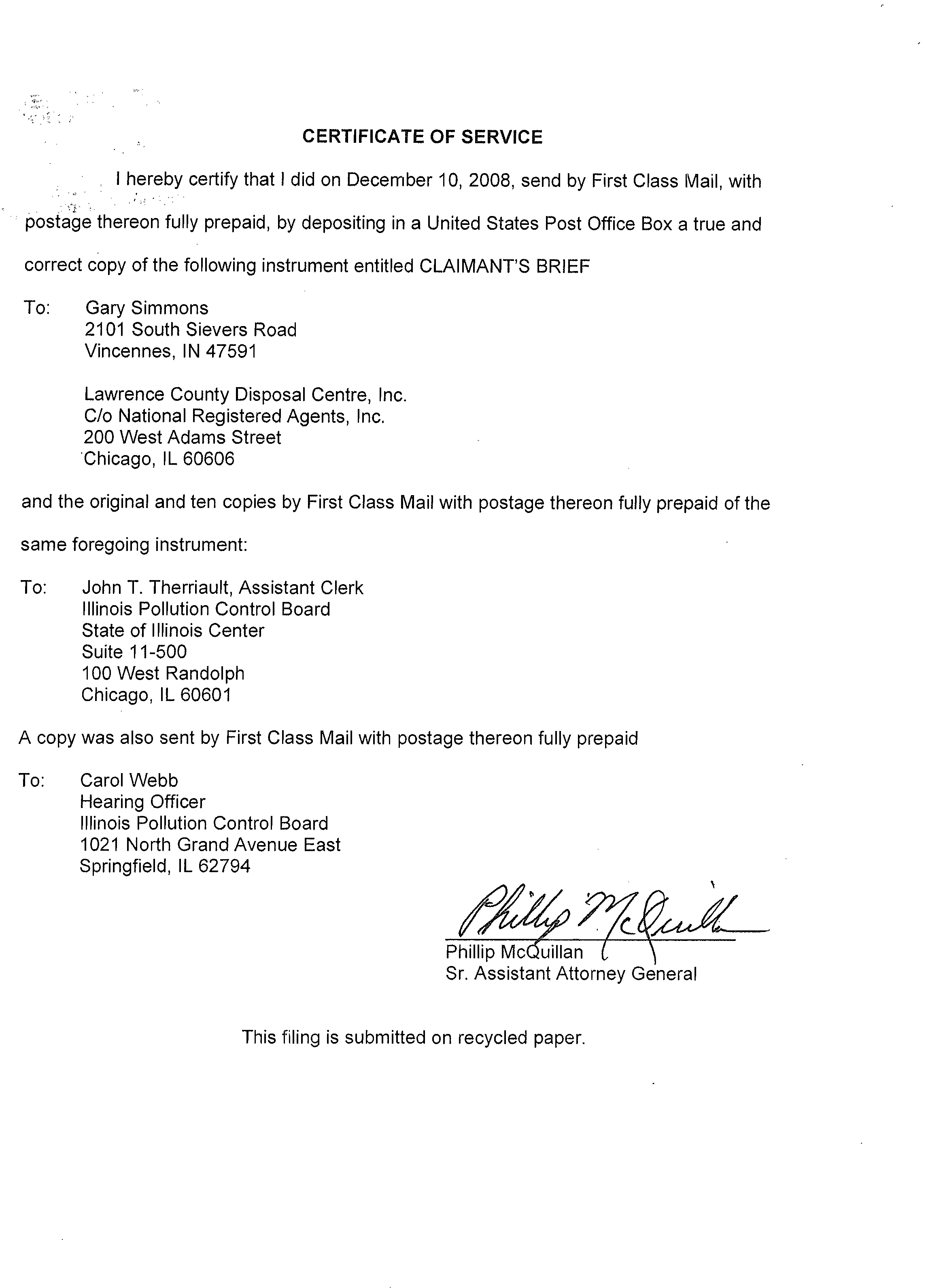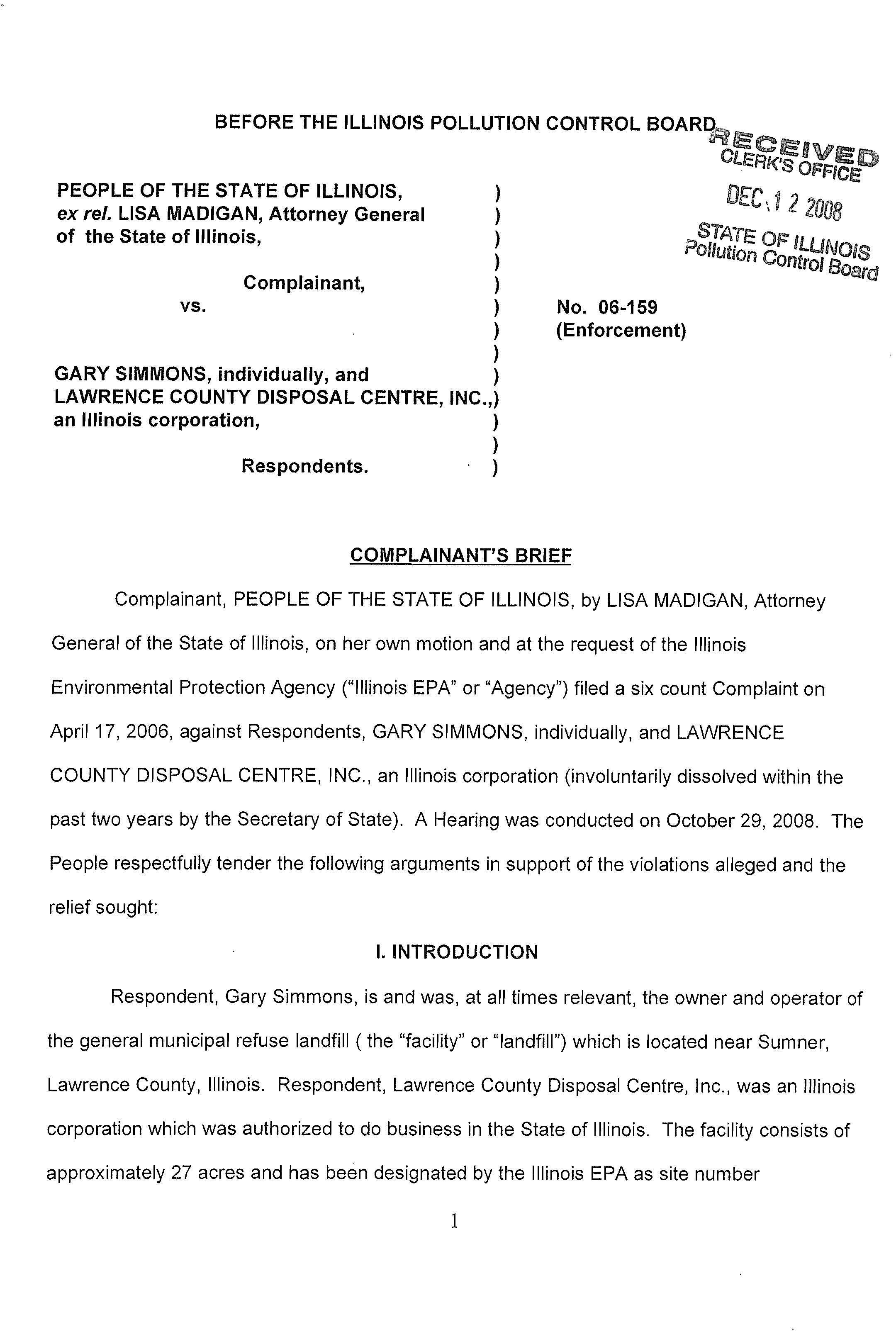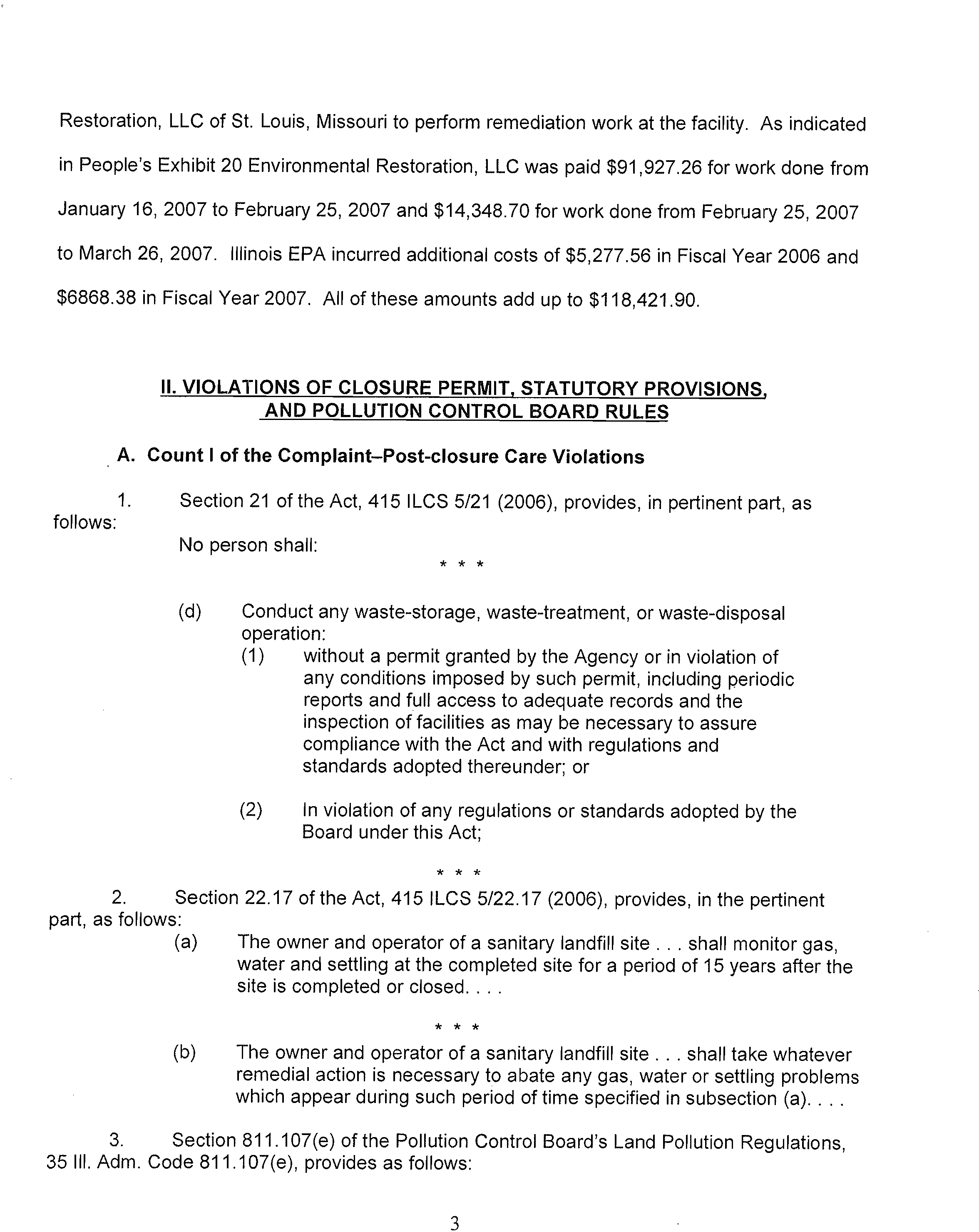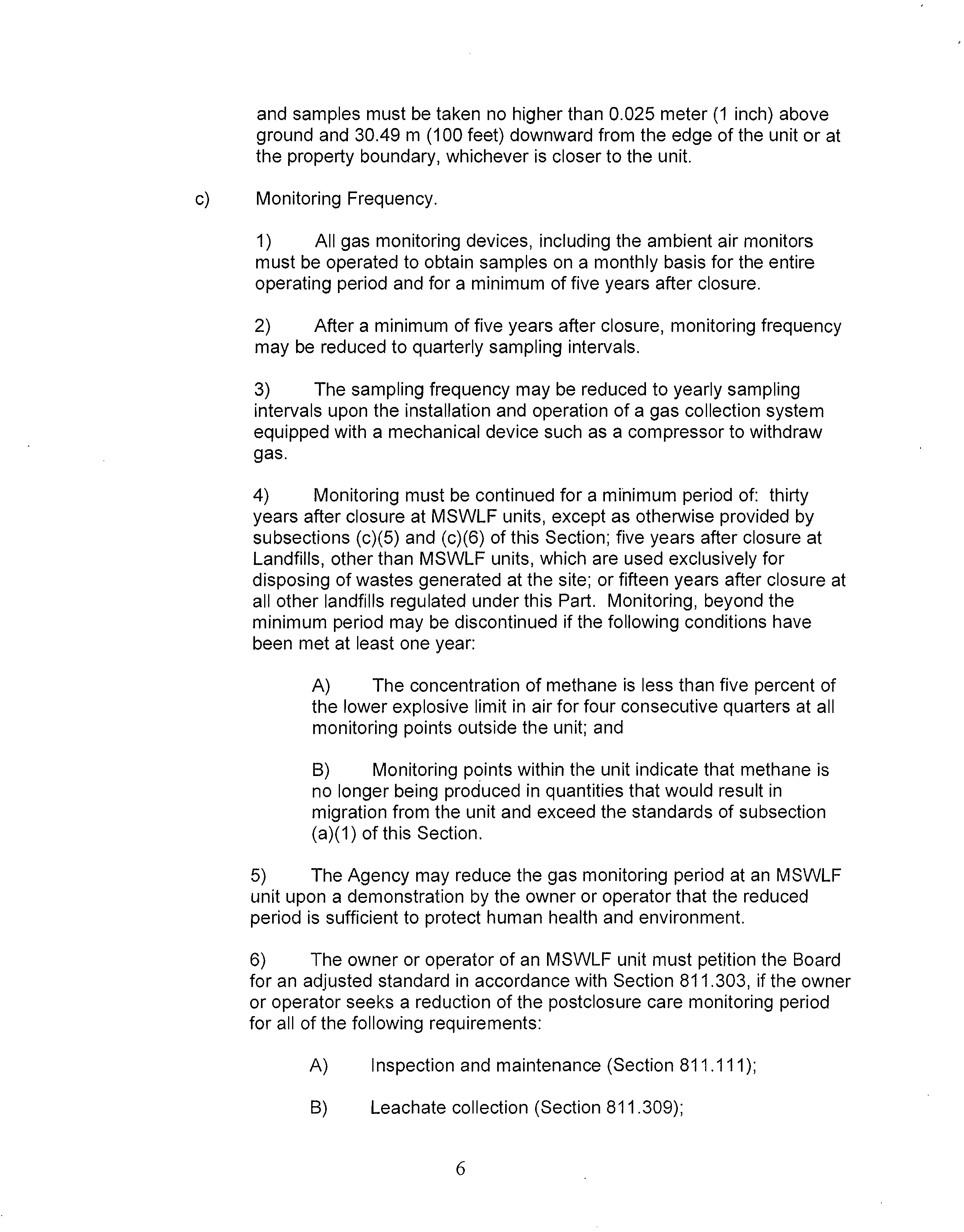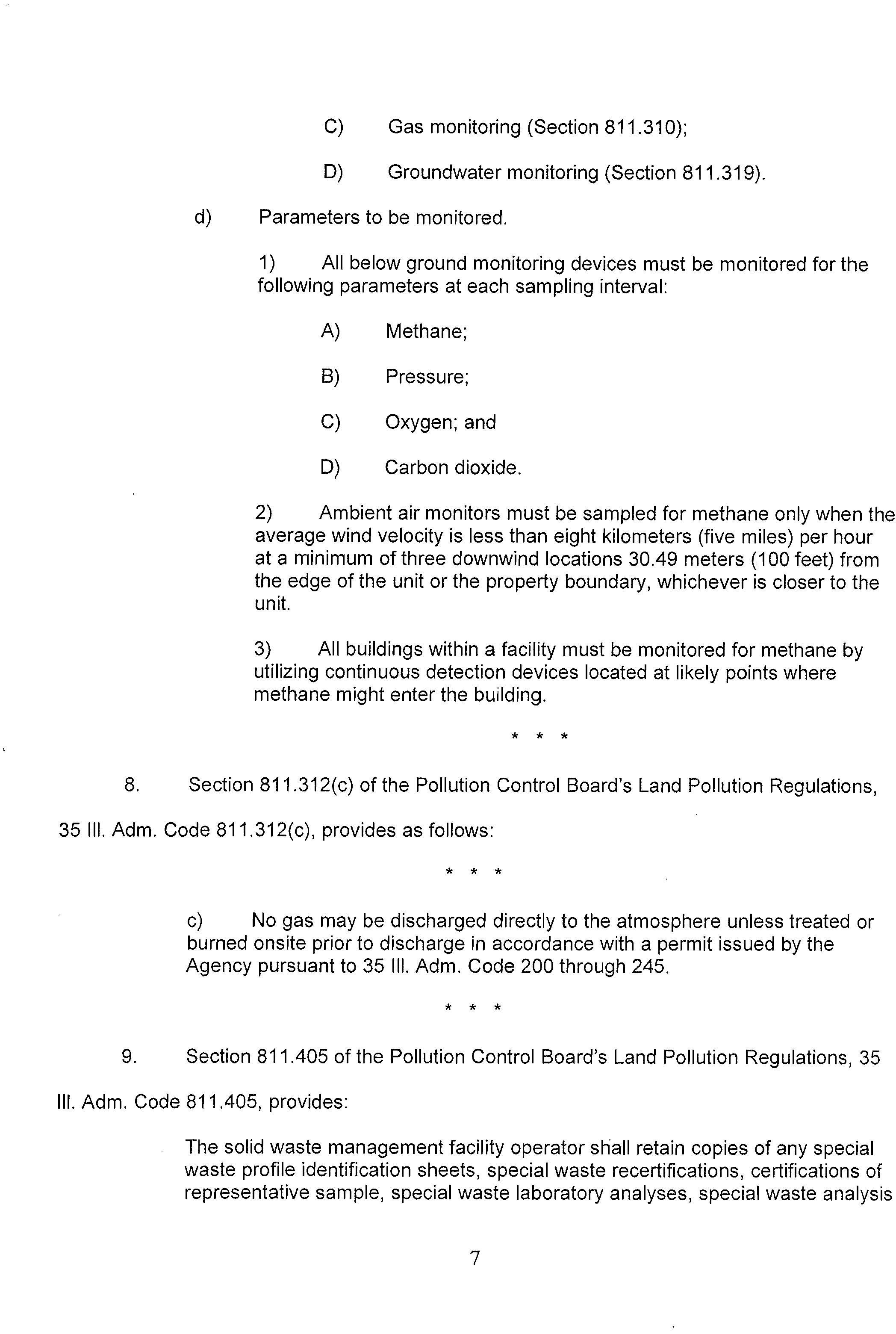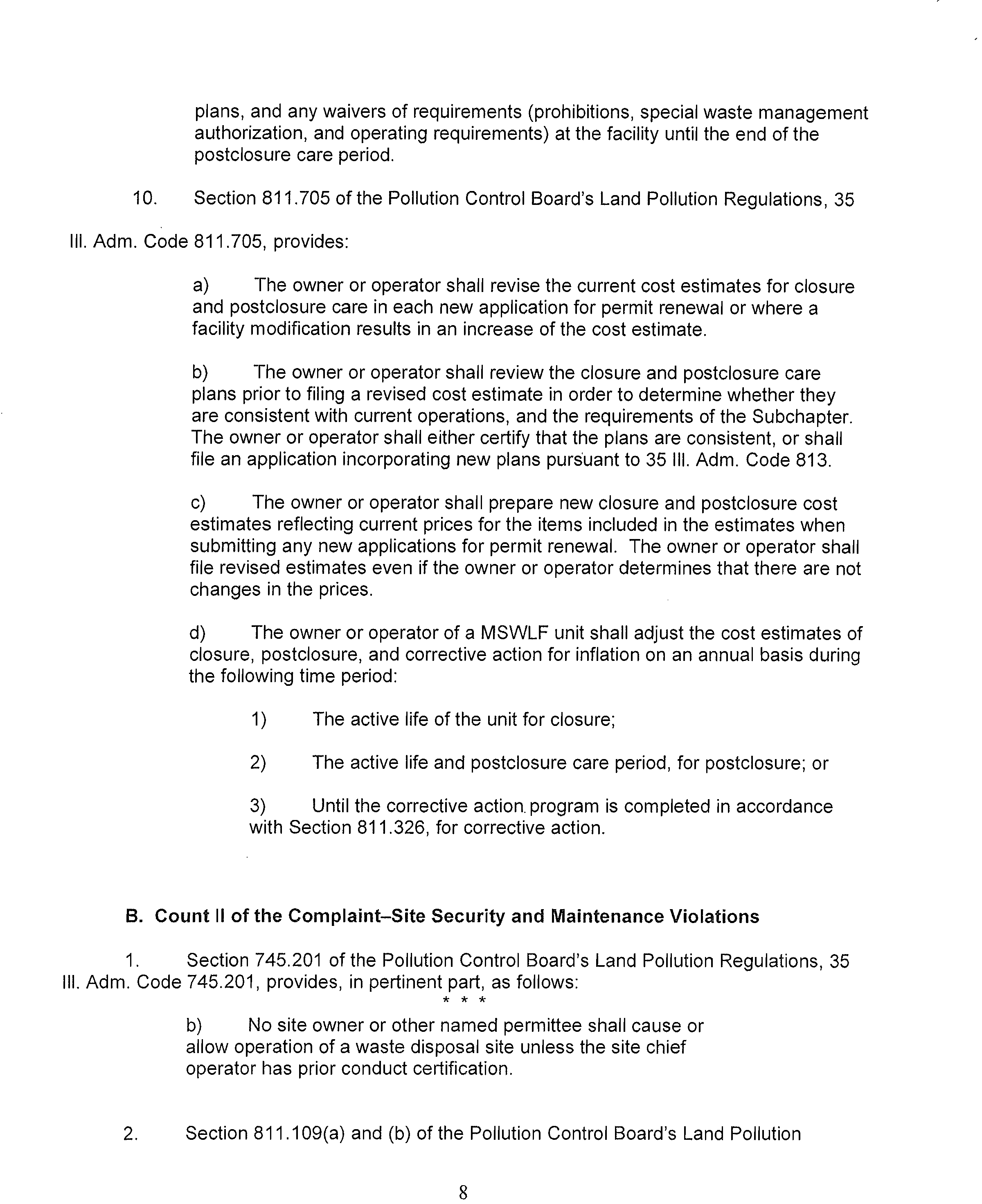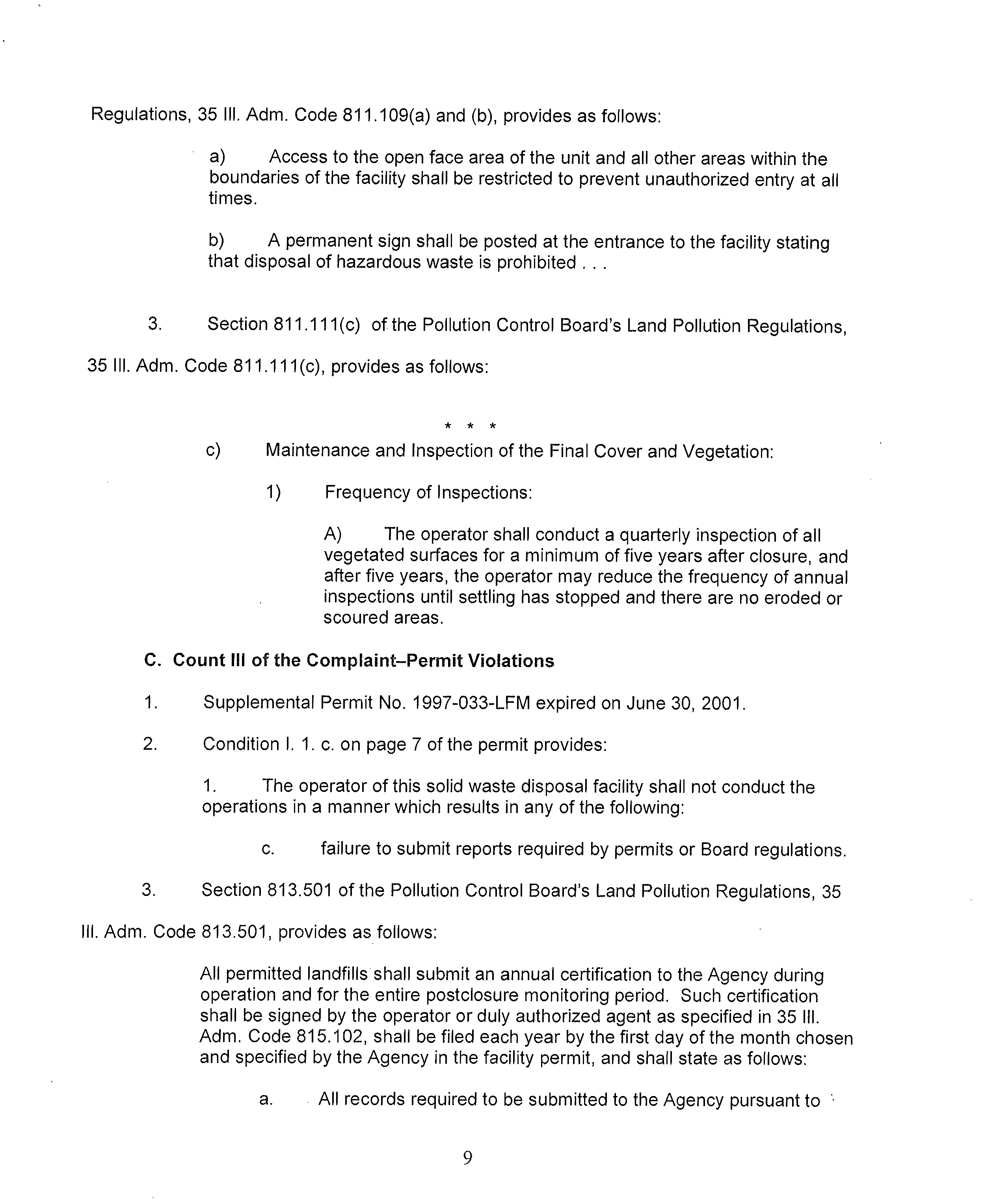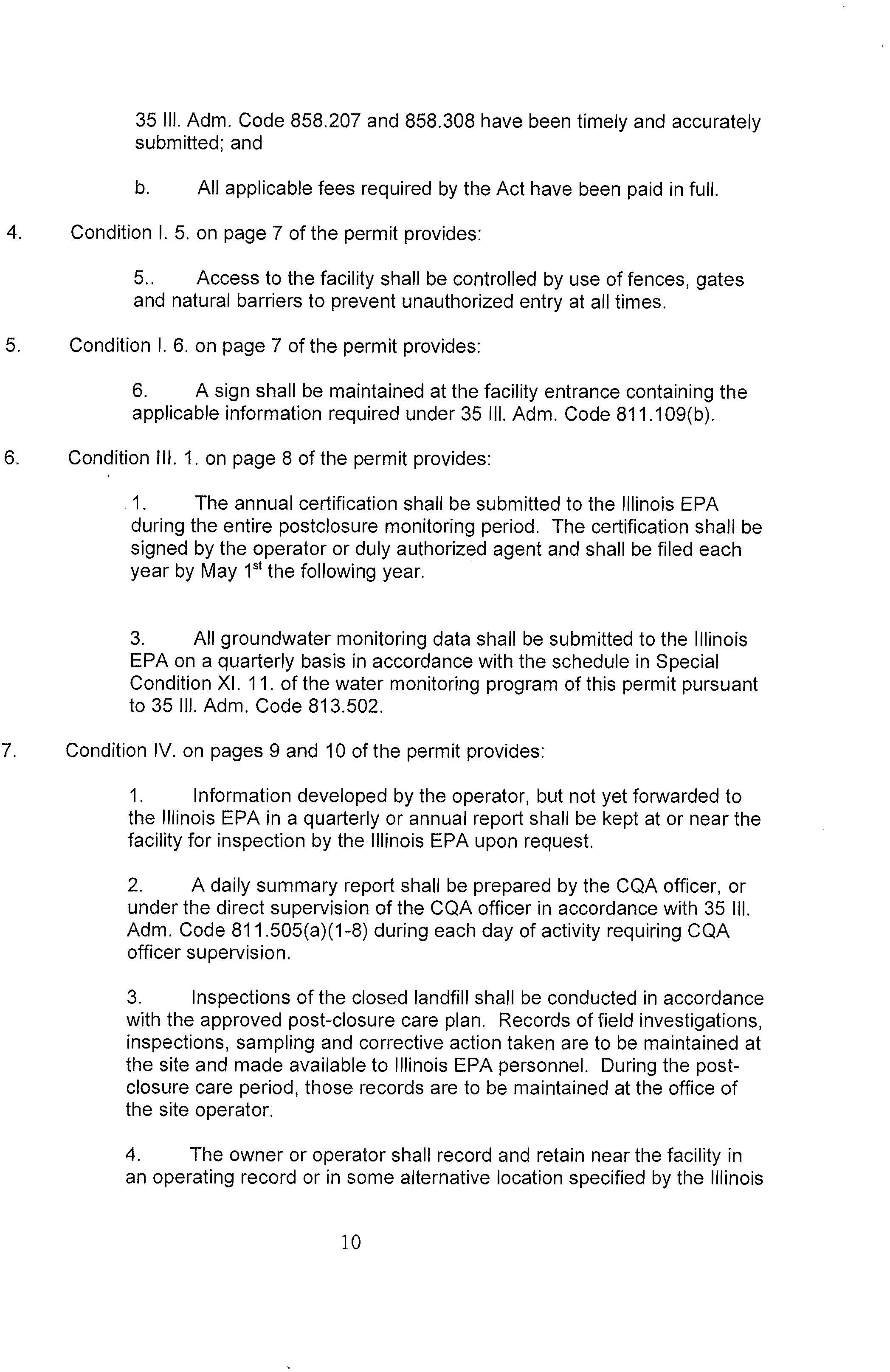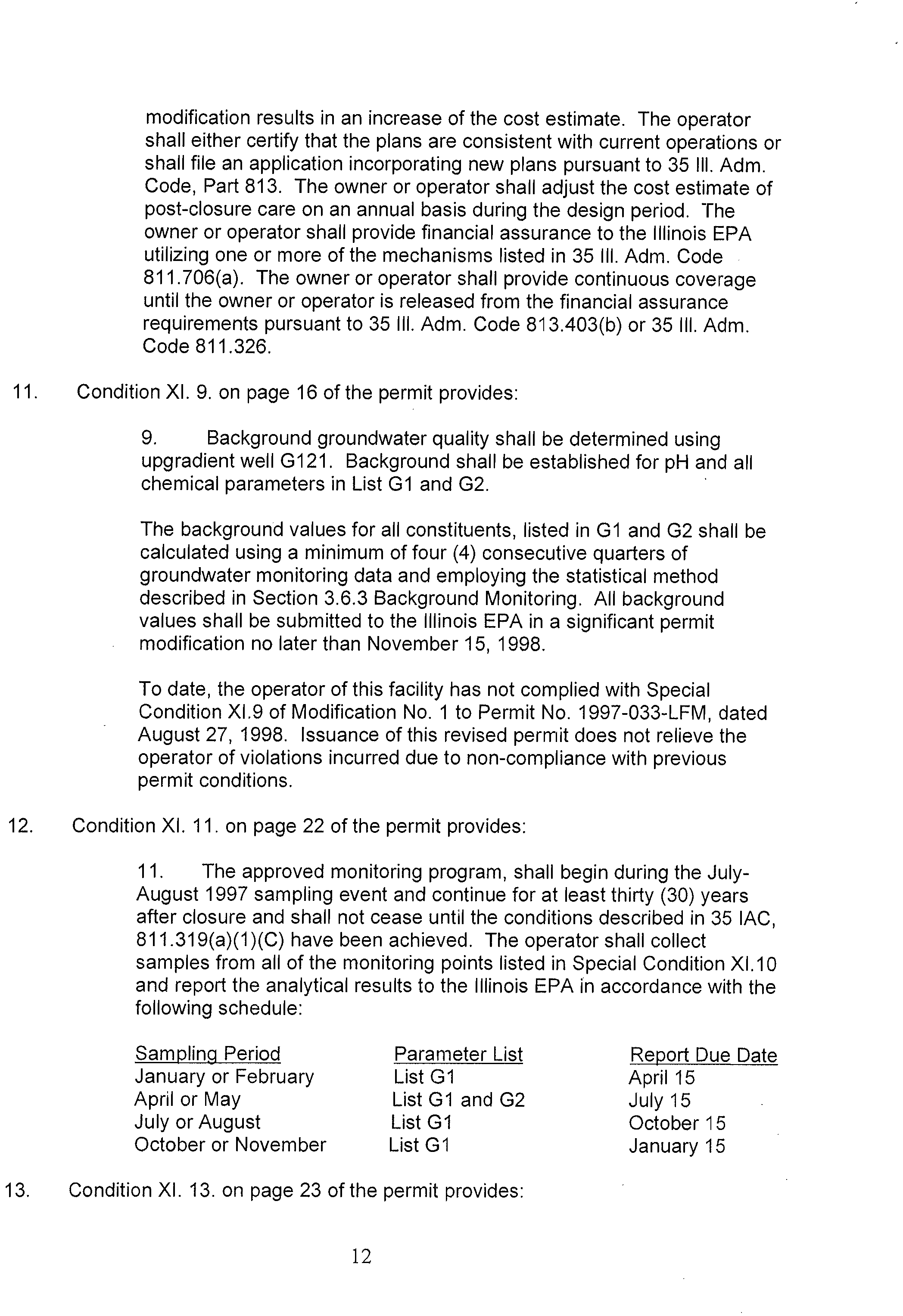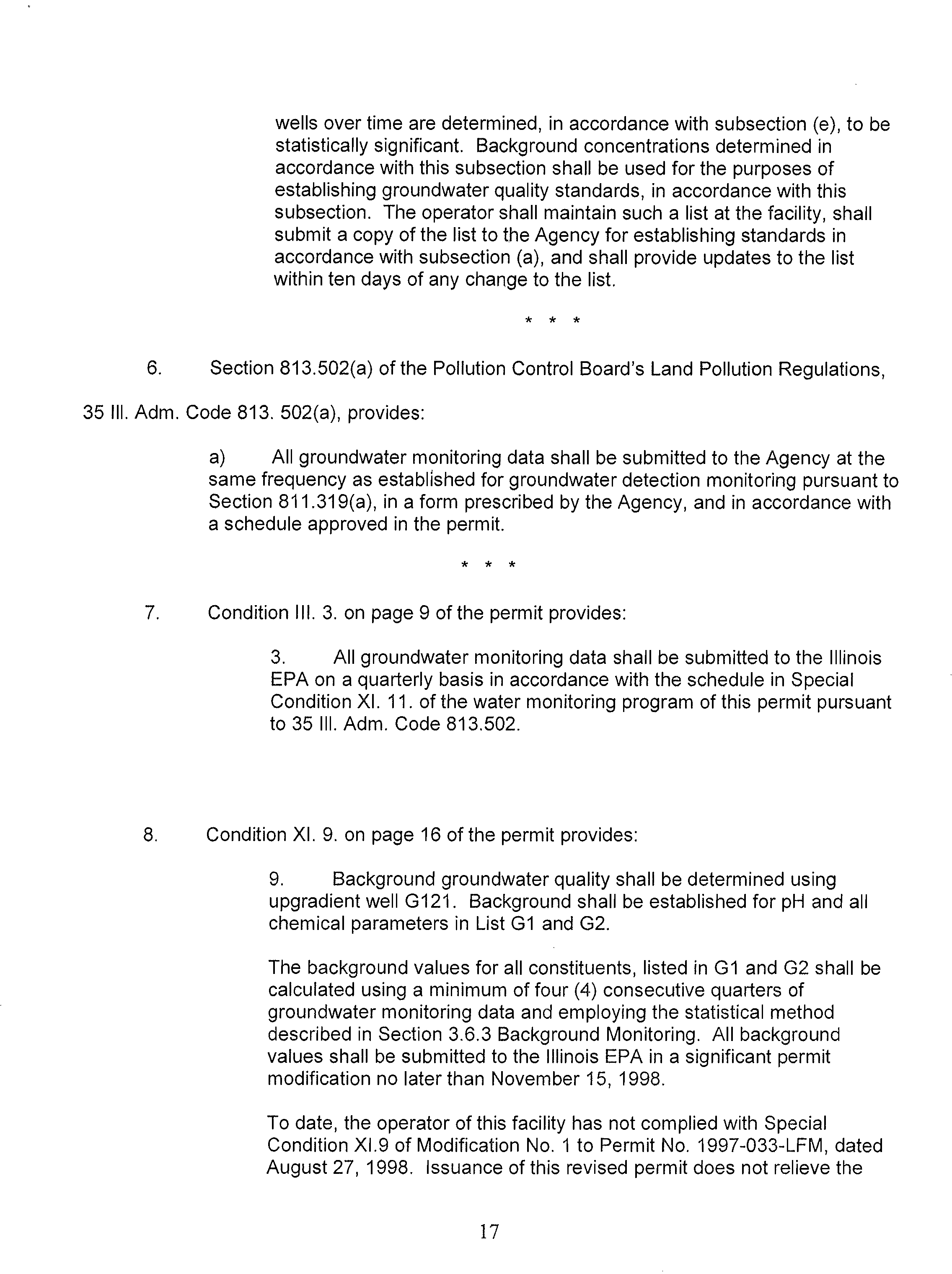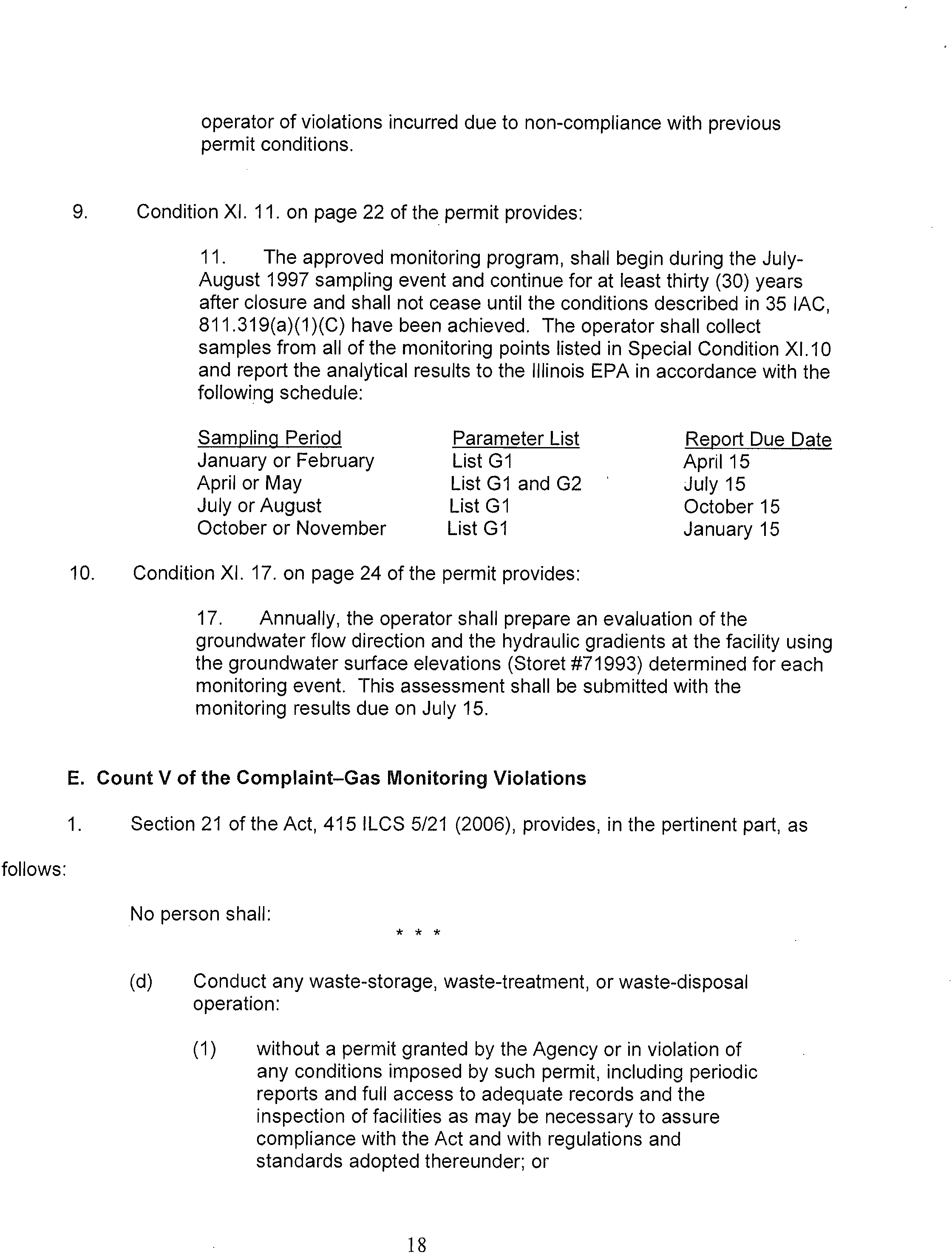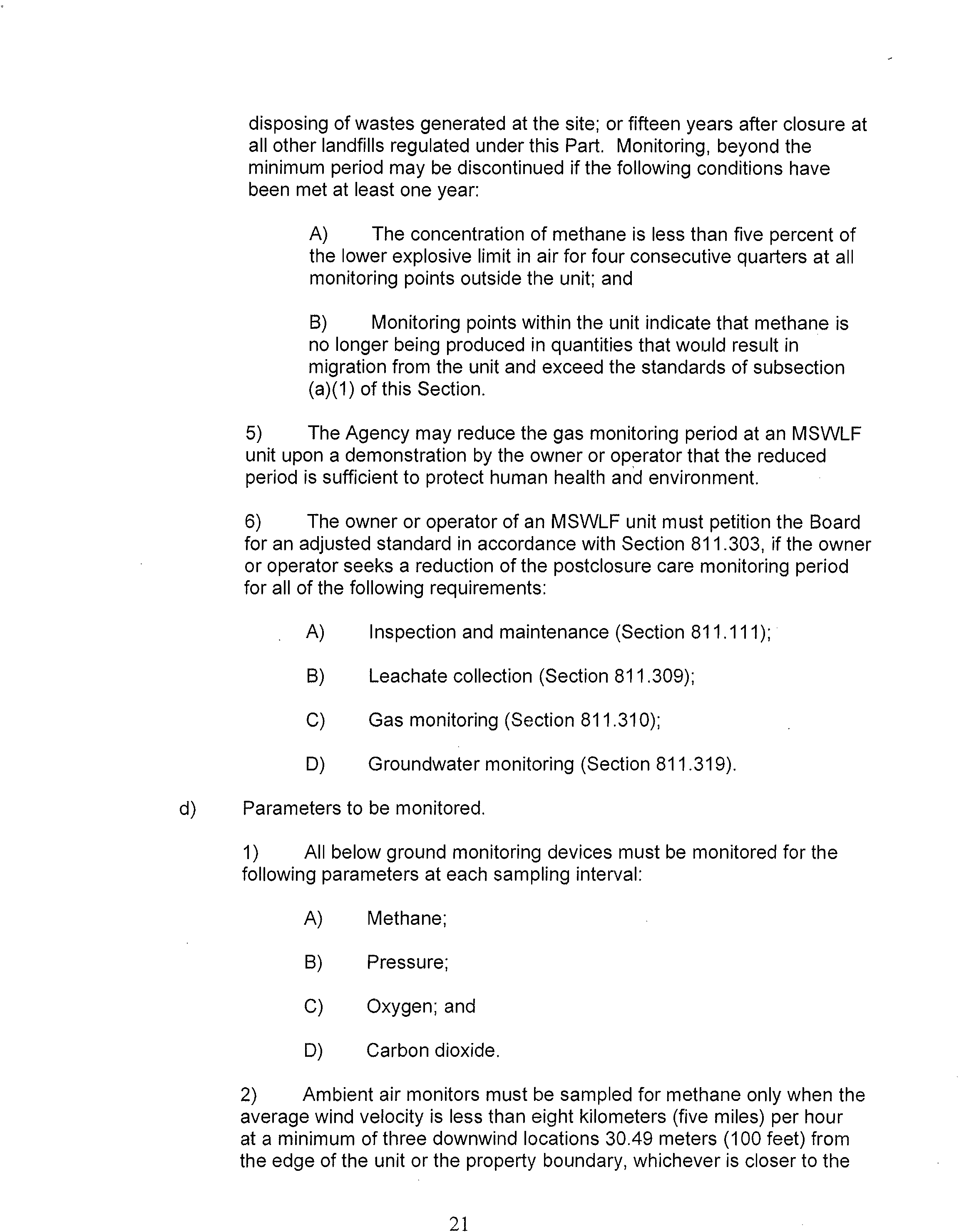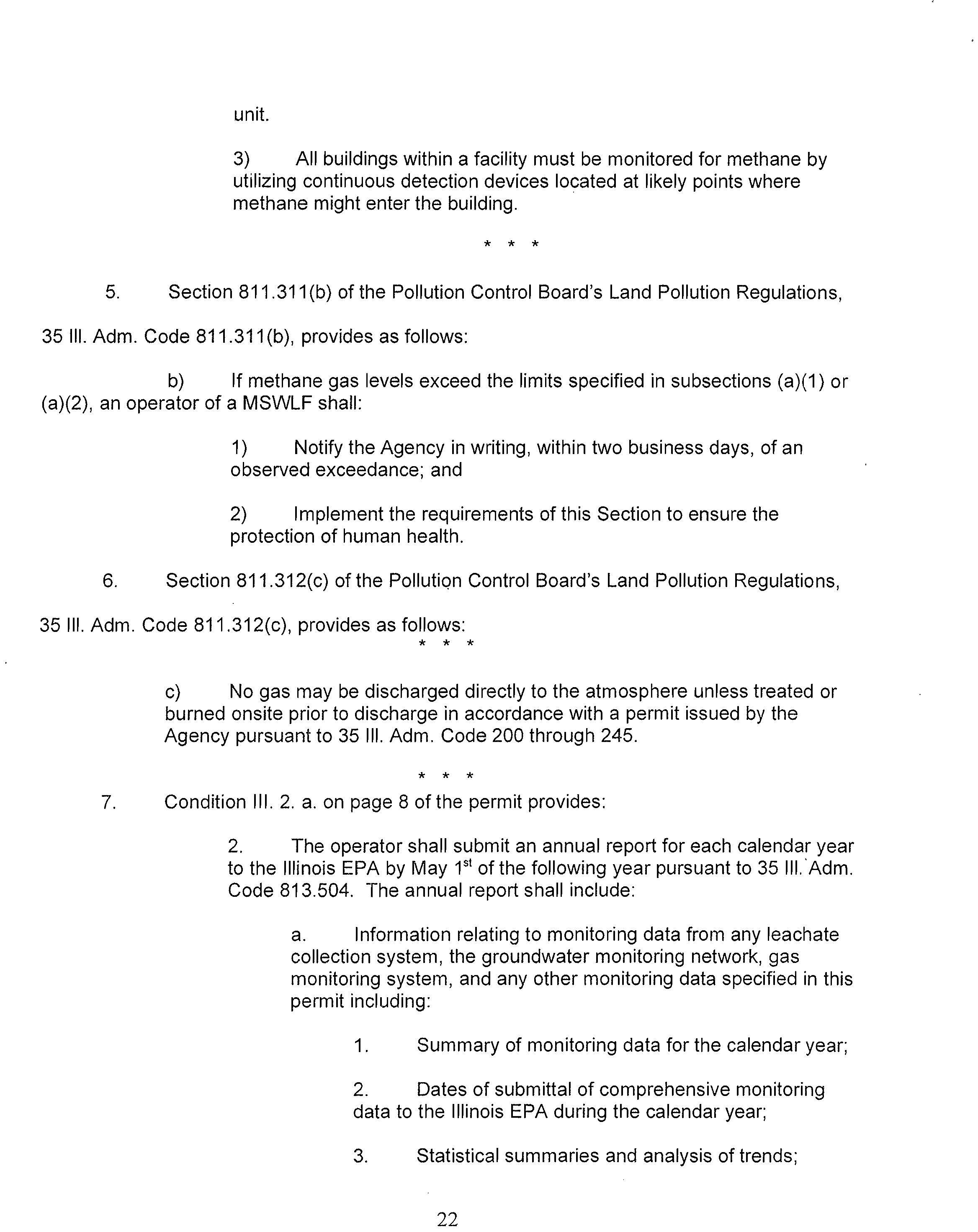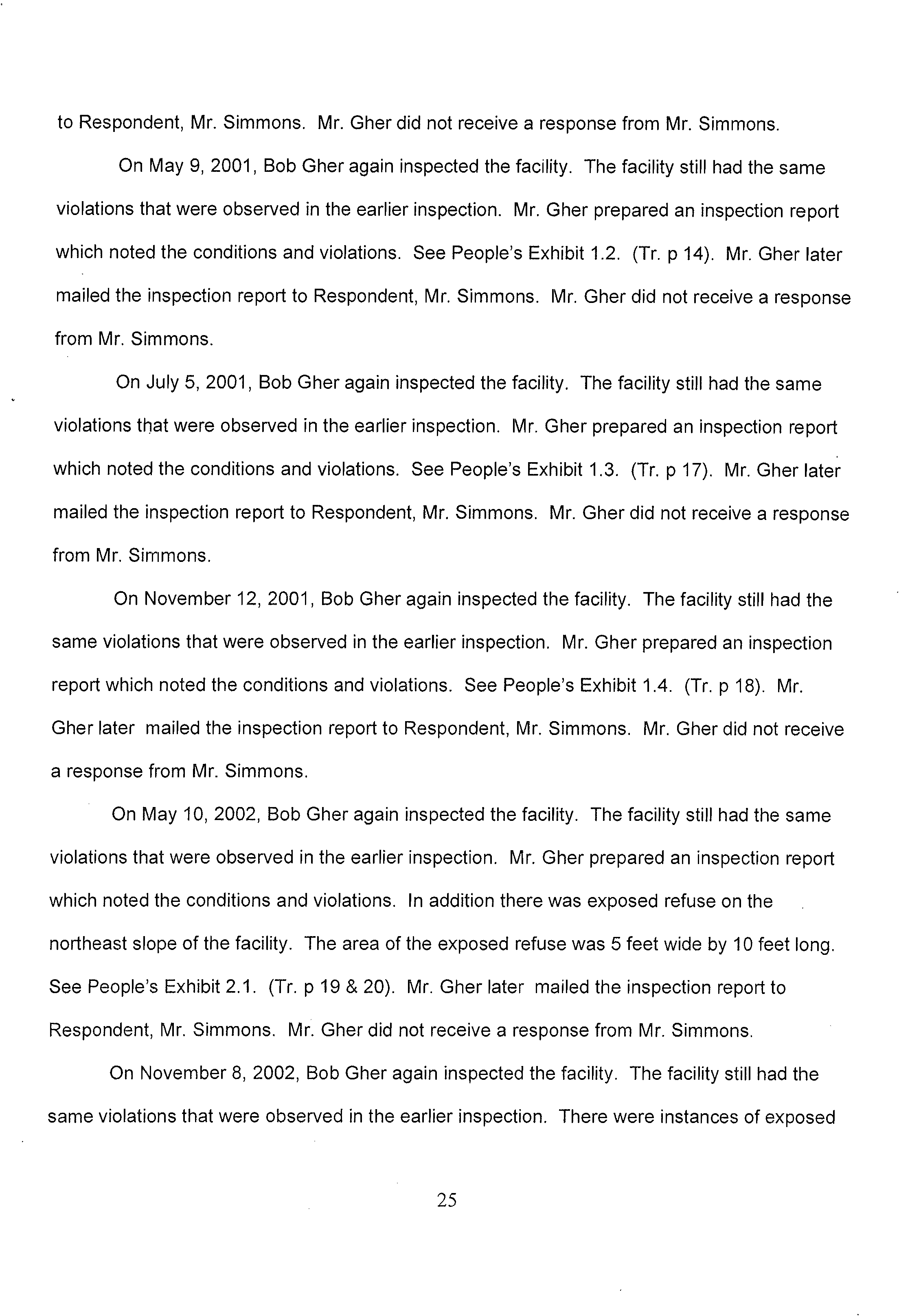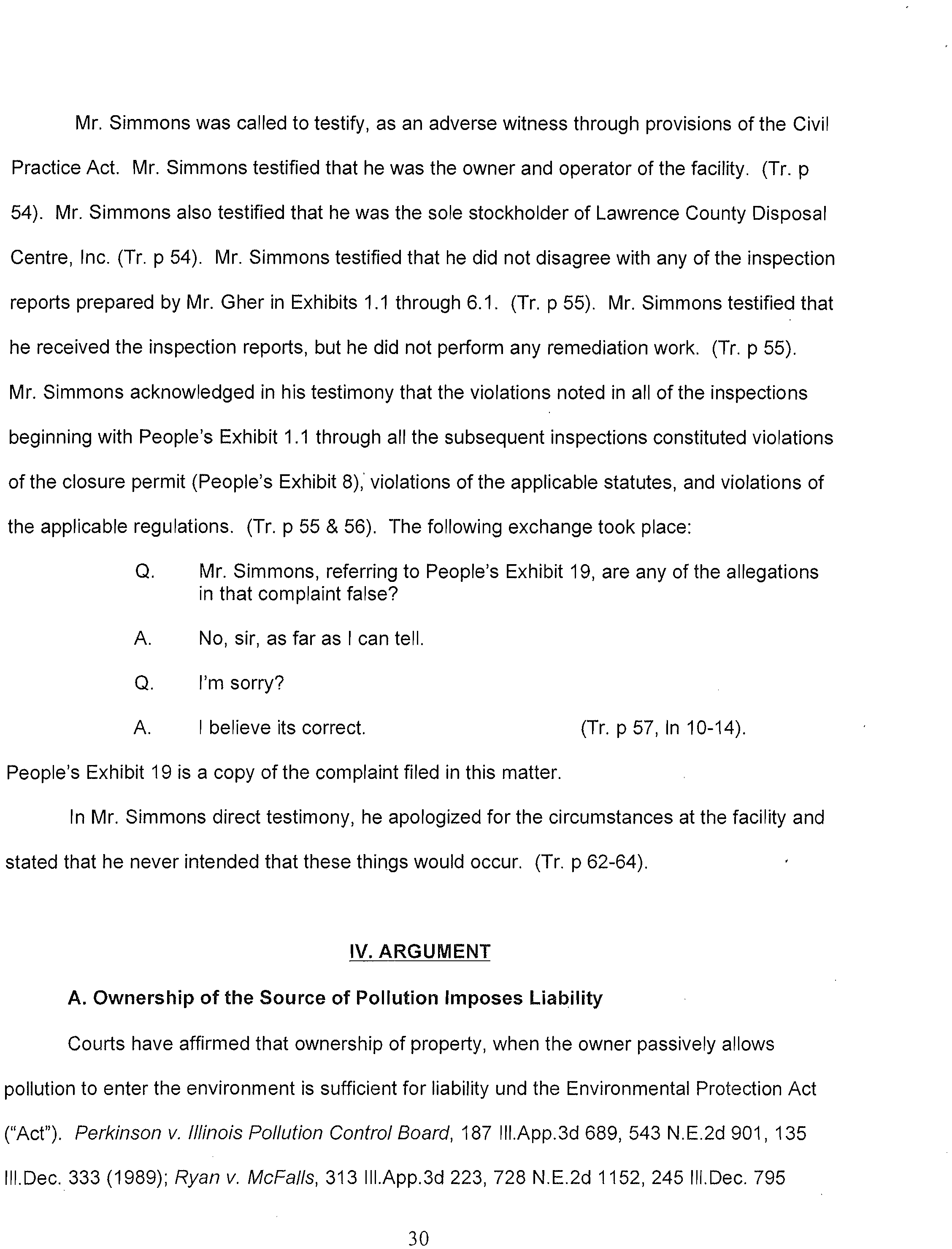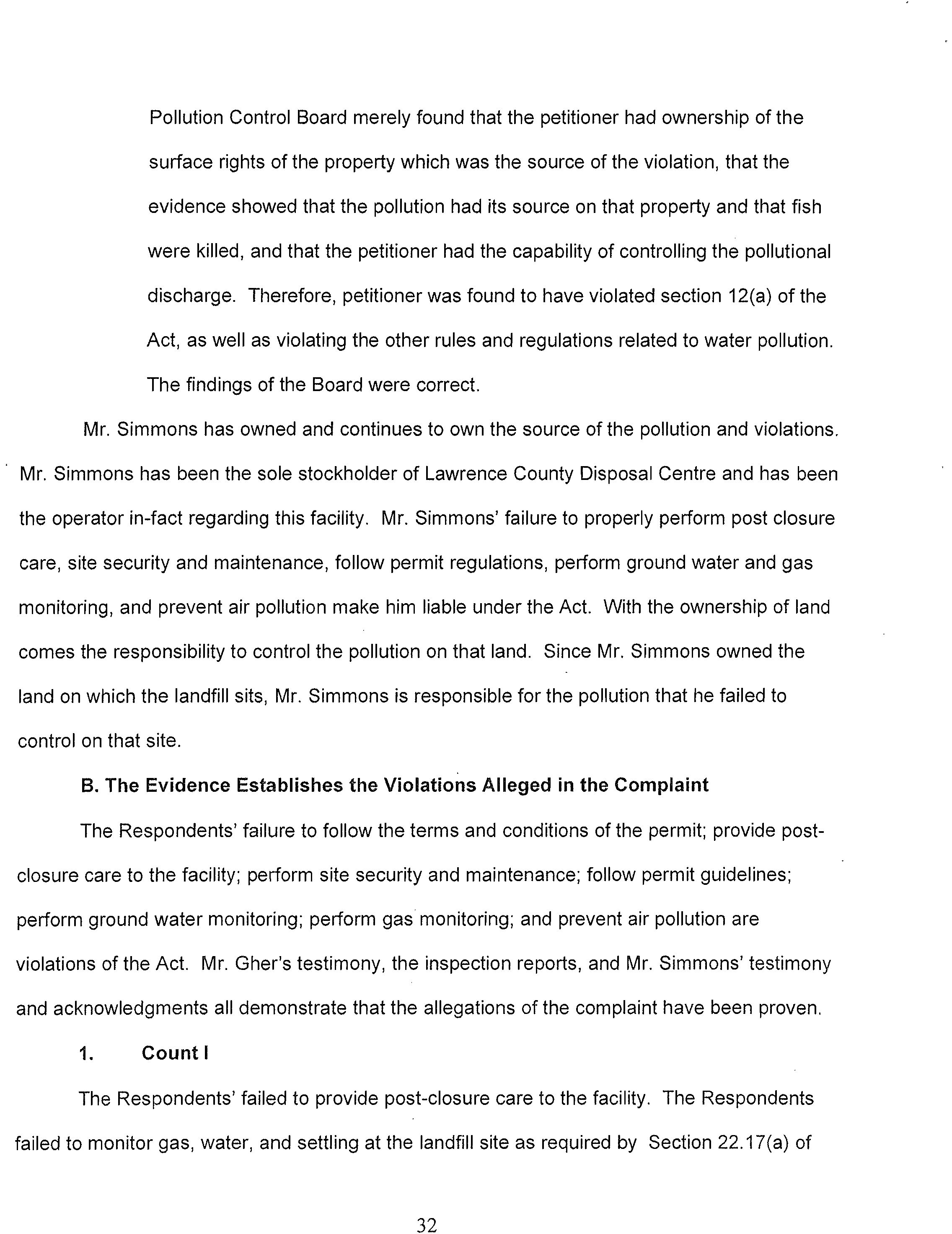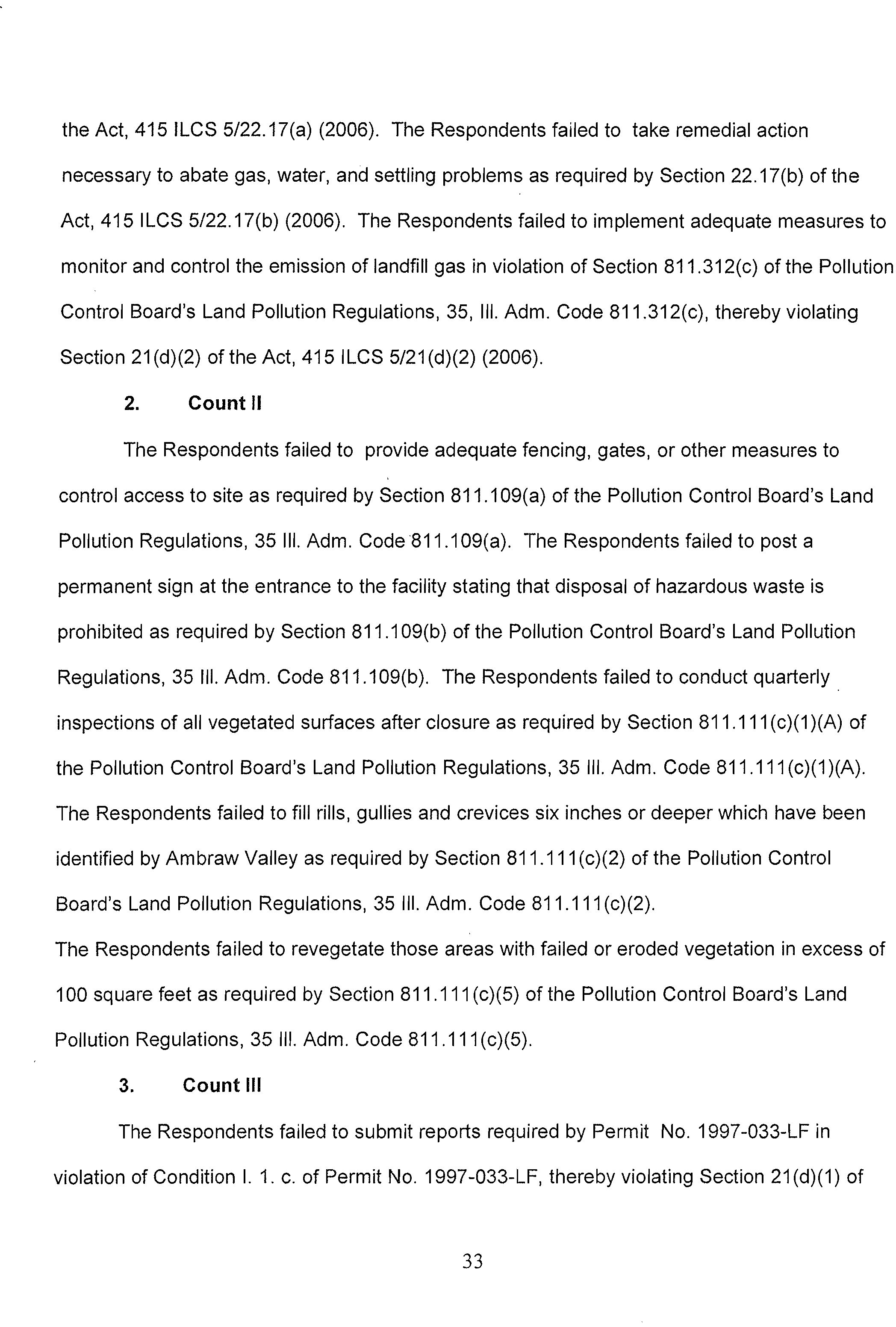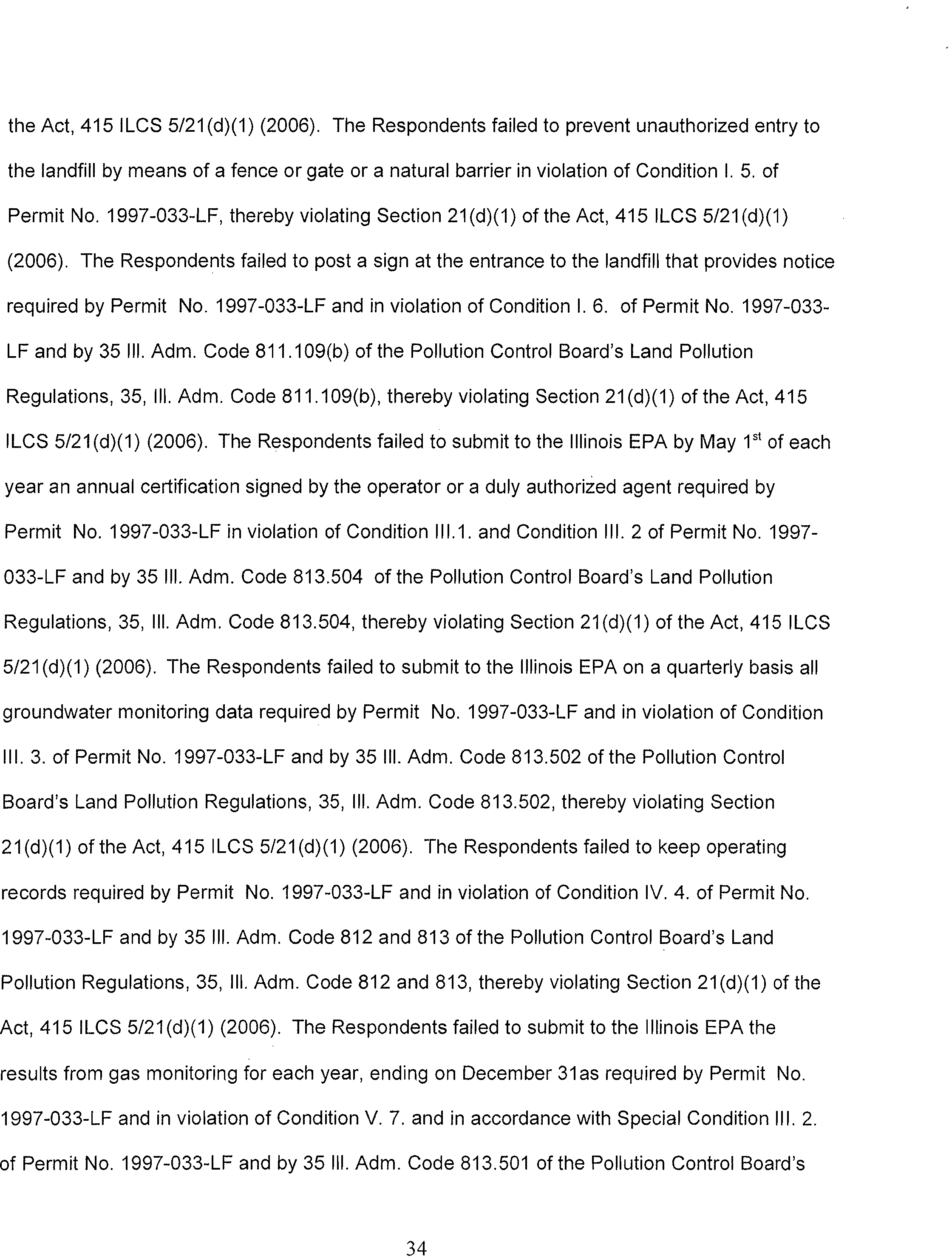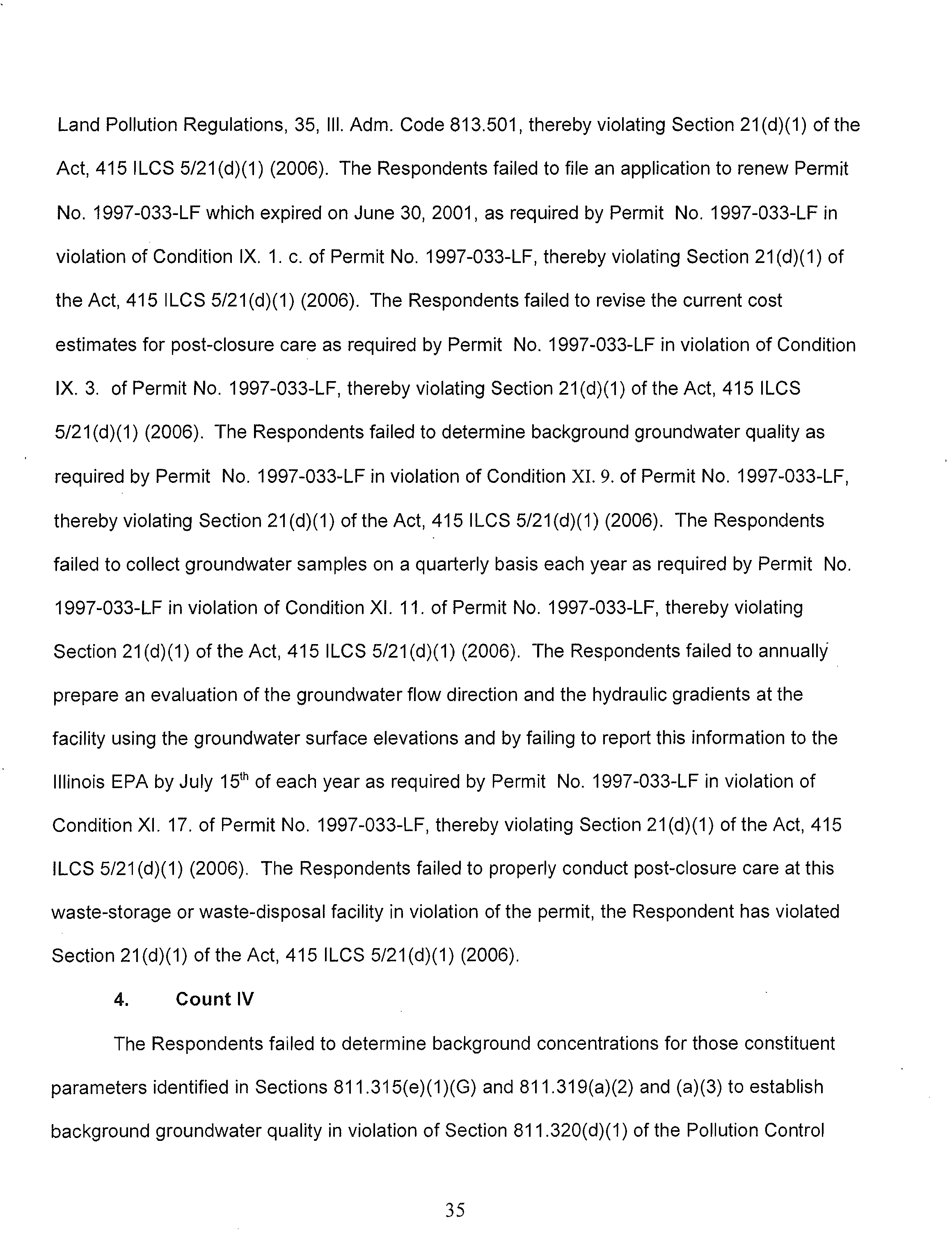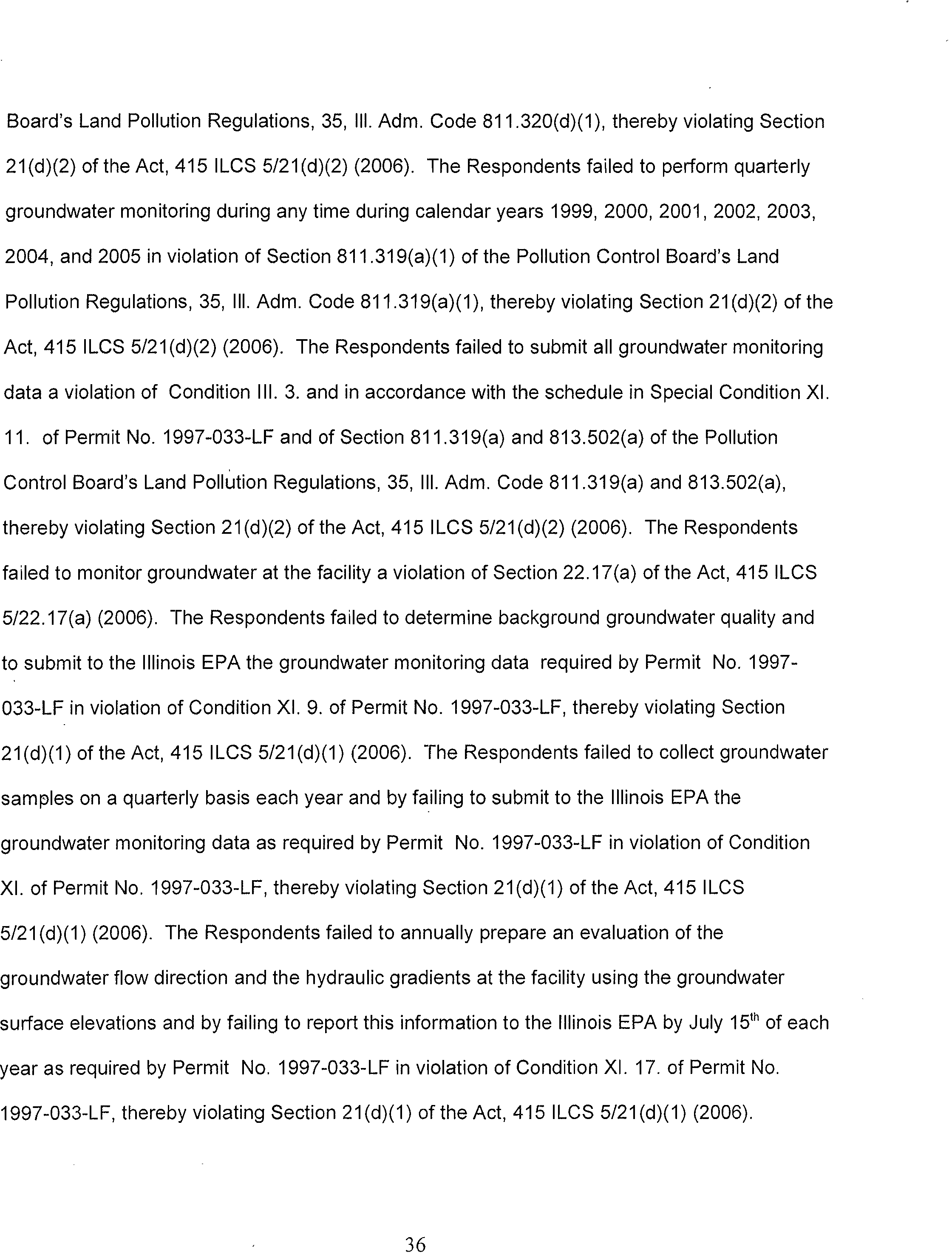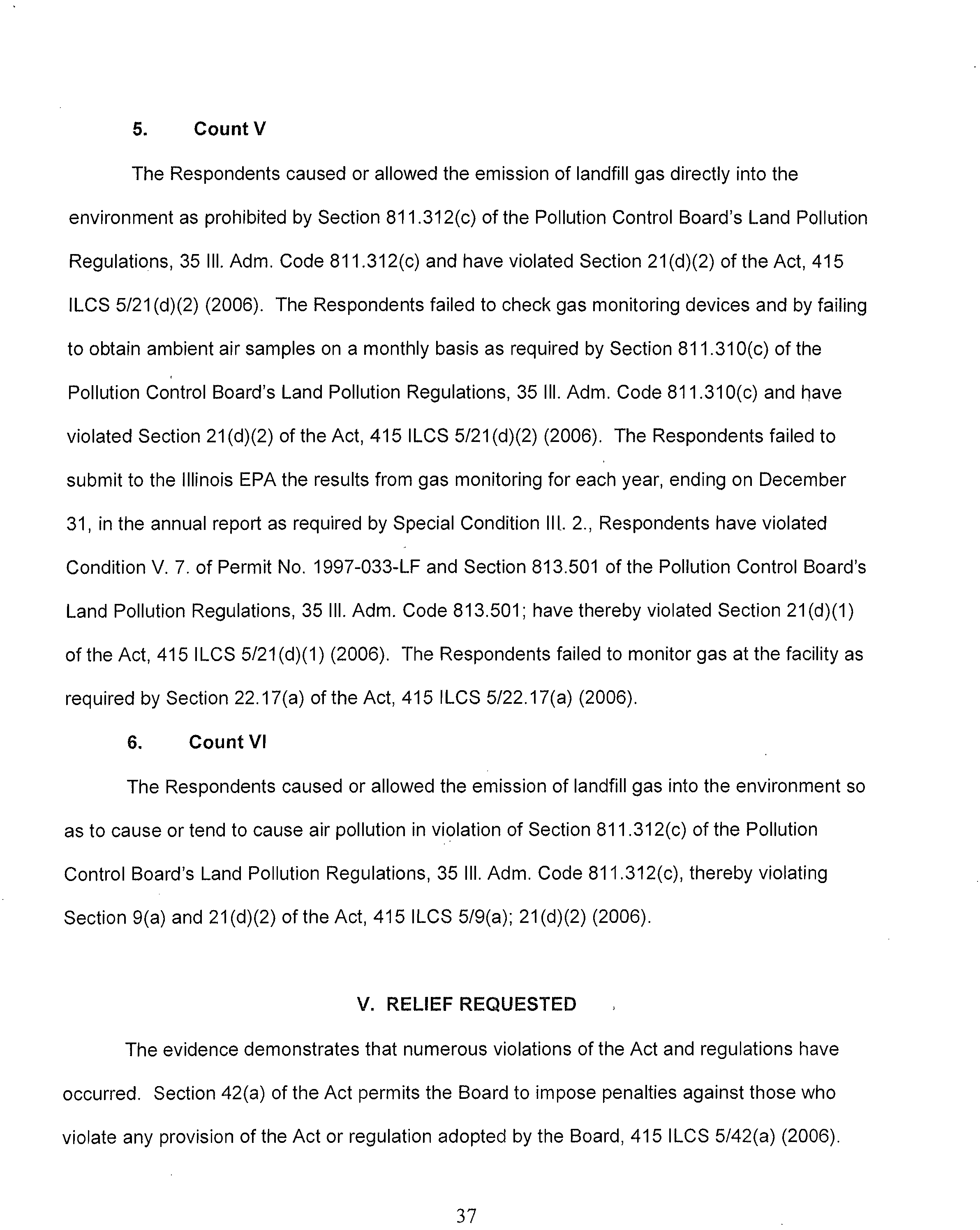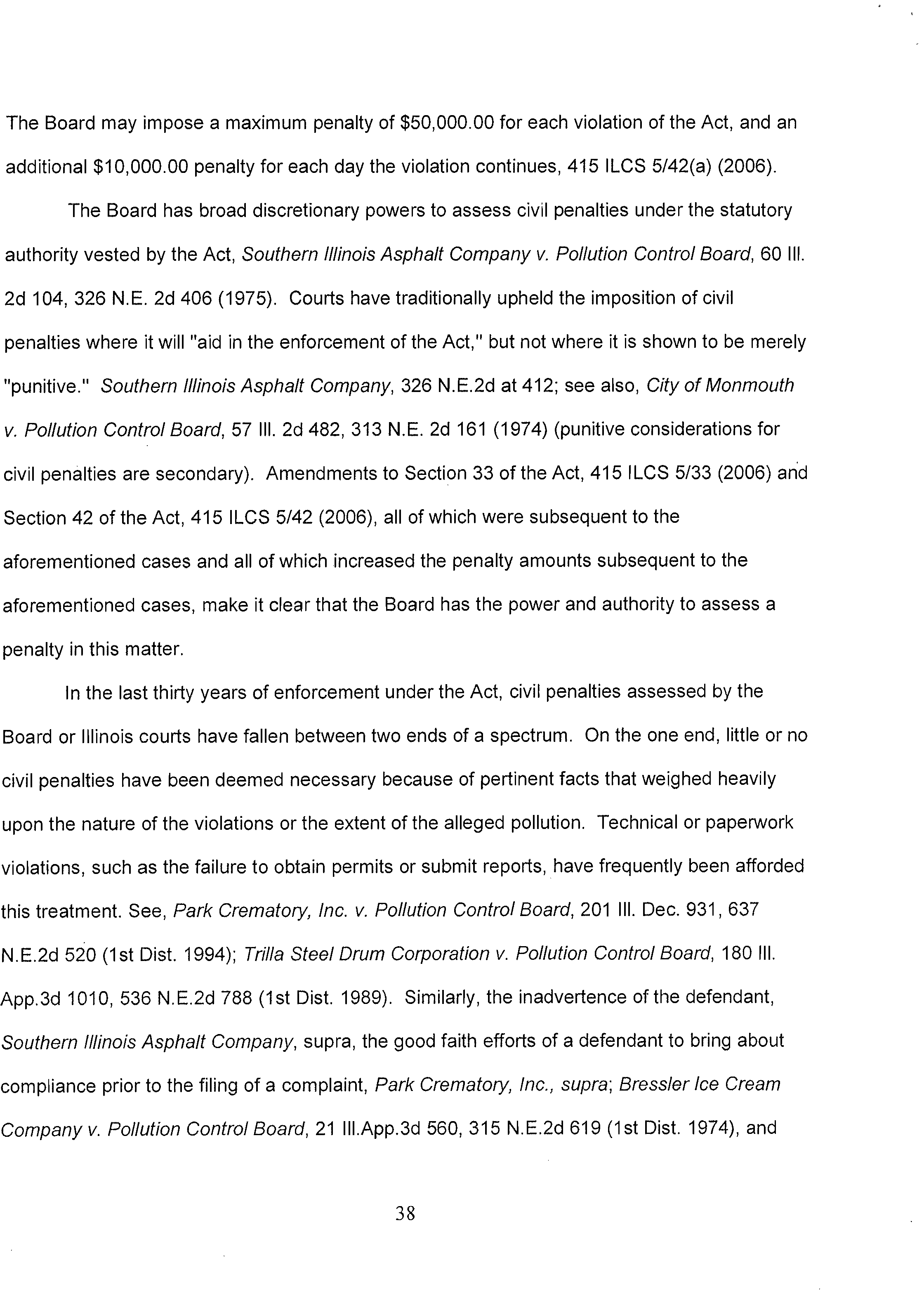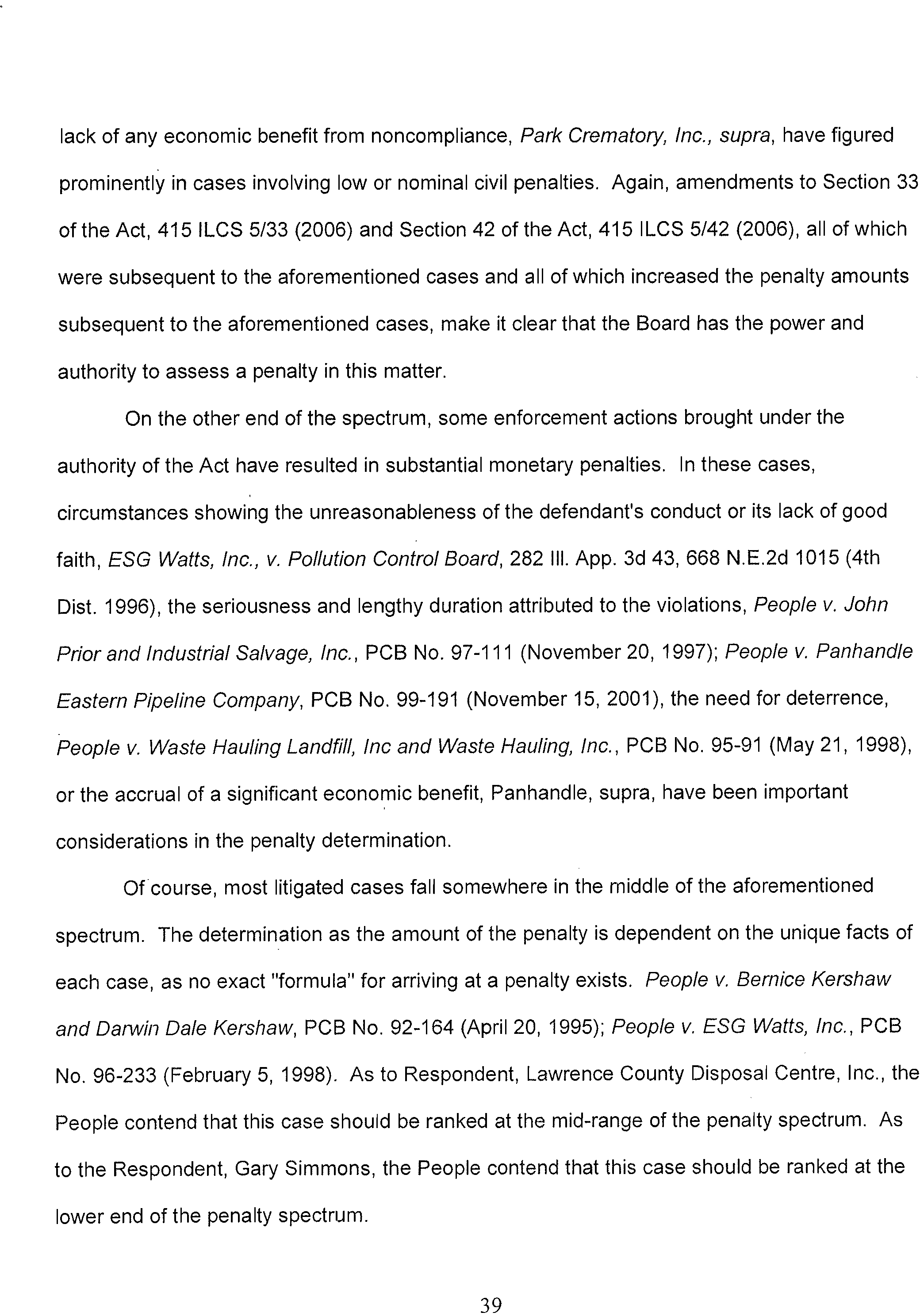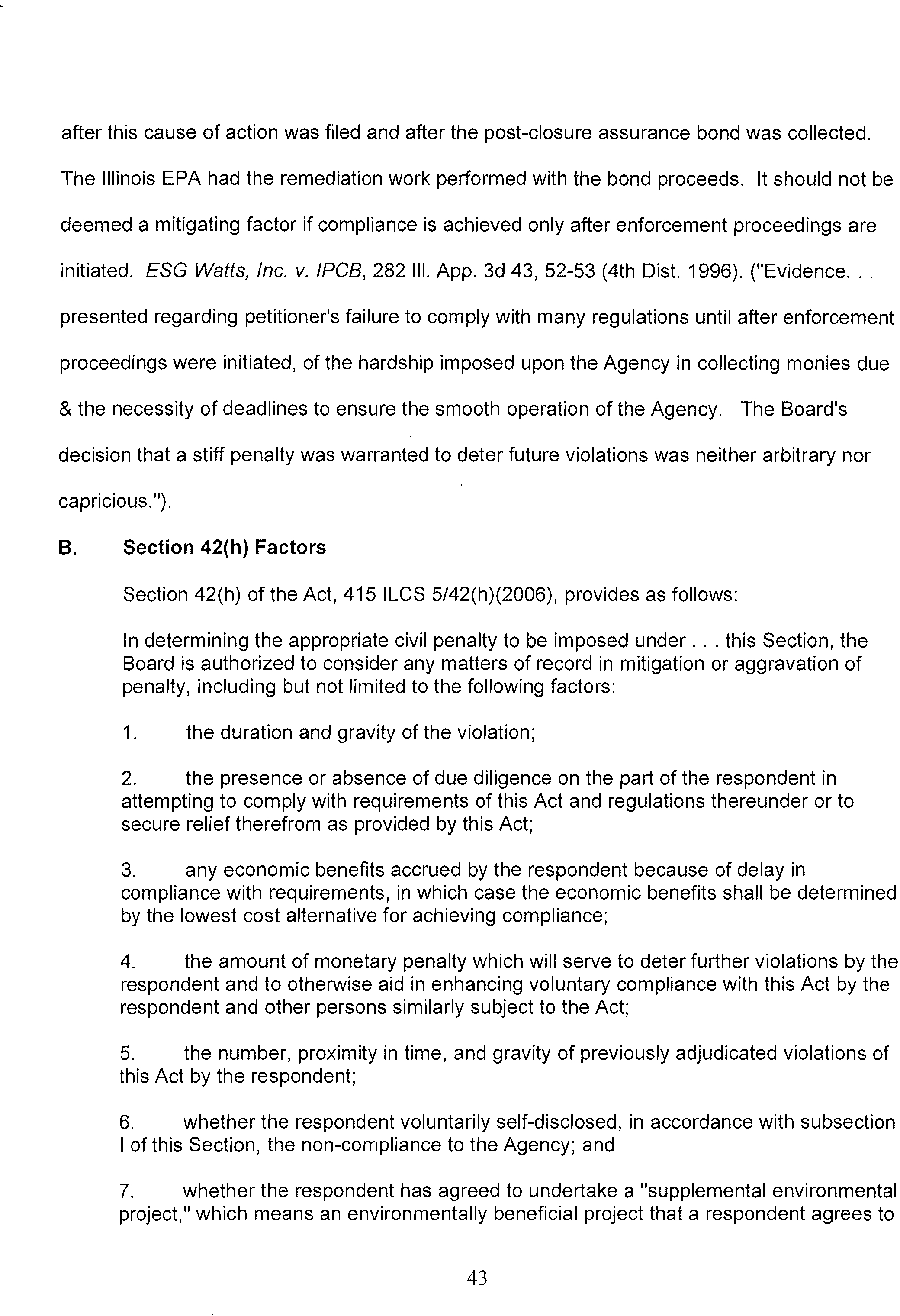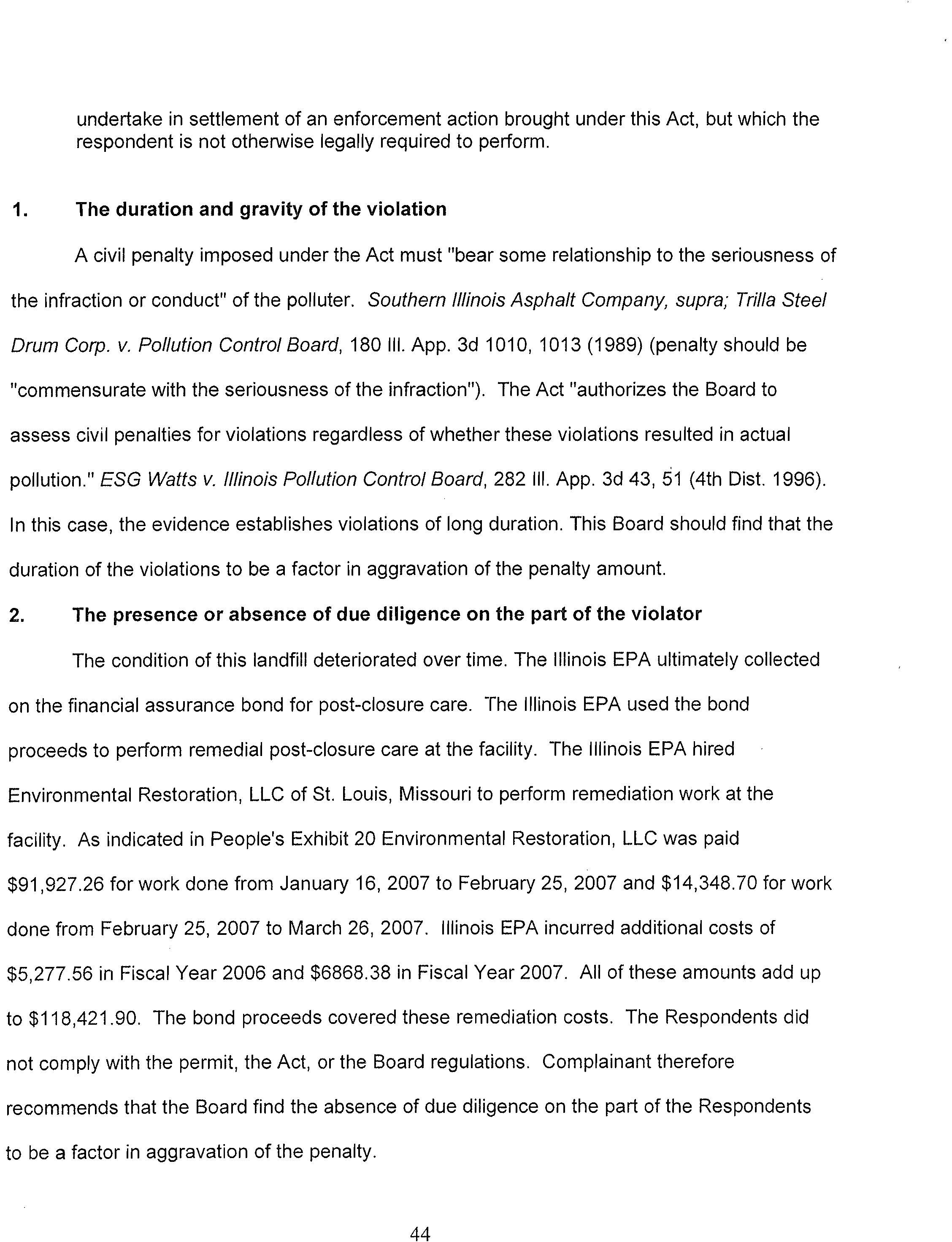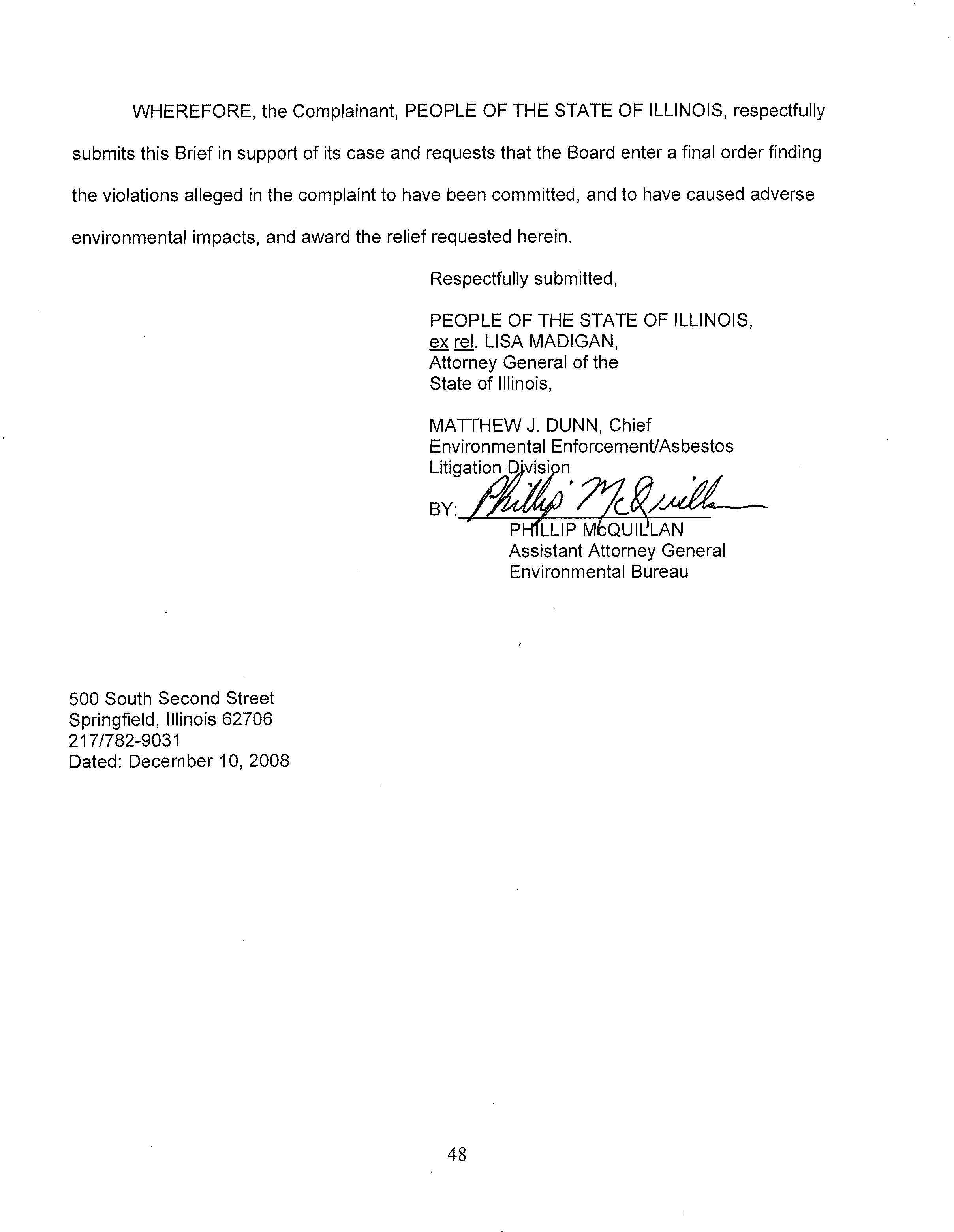BEFORE THE
ILLINOIS POLLUTION CONTROL BOARD
KS
PEOPLE
OF THE STATE
OF ILLINOIS,
)
DEC,,
12
2U08
Complainant,
)
pQf/TE
OFILLINO
v.
)
PCB
NO.
06-1 59
)
(Enforcement)
GARY SIMMONS,
individually, and
)
LAWRENCE
COUNTY DISPOSAL
CENTRE,
INC., an Illinois corporation,
)
Respondents.
).
NOTICE
OF FILING
To:
Gary Simmons
2101
South Sievers
Road
Vincennes,
IN
47591
Lawrence County Disposal Centre, Inc.
C/o National Registered Agents,
Inc.
200
West Adams Street
Chicago, IL 60606
PLEASE TAKE NOTICE that on this date I mailed for filing
with
the
Clerk of the
Pollution
Control Board of the State of Illinois, COMPLAINT’S BRIEF, a copy of which
is attached hereto
and
herewith
served upon you.
Respectfully submitted,
PEOPLE
OF
THE
STATE OF ILLINOIS
LISA
MADIGAN
Attorney General
of the
State of Illinois
MATTHEWJ.
DUNN, Chief
Environmental
Enforcement/Asbestos
Lgat’viio
Phillip
McQuillan(
Assistant Attorney
General
Environmental
Bureau
500
South Second
Street
Springfield, Illinois
62706
217/782-9031
Dated:
December 10,
2008
CERTIFICATE
OF
SERVICE
I hereby
certify
that I
did on December
10,
2008,
send
by
First
Class
Mail,
with
postae
thereon
fully
prepaid,
by
depositing
in a
United
States
Post Office
Box
a
true
and
correct
copy
of the
following
instrument
entitled
CLAIMANT’S
BRIEF
To:
Gary
Simmons
2101
South
Sievers
Road
Vincennes,
IN 47591
Lawrence
County
Disposal
Centre,
Inc.
C/o
National
Registered
Agents,
Inc.
200
West
Adams
Street
‘Chicago,
IL 60606
and
the original
and
ten copies
by
First Class
Mail
with
postage
thereon
fully
prepaid
of the
same
foregoing
instrument:
To:
John
T.
Therriault,
Assistant
Clerk
Illinois
Pollution
Control
Board
State
of
Illinois
Center
Suite 11-500
100 West
Randolph
Chicago,
IL 60601
A
copy was
also
sent
by First
Class
Mail
with postage
thereon
fully
prepaid
To:
Carol
Webb
Hearing
Officer
Illinois
Pollution
Control
Board
1021
North
Grand
Avenue
East
Springfield,
IL
62794
Phillip
Mc
ulilan
(.
Sr. Assistant
Attorney
General
This filing
is submitted
on
recycled
paper.
BEFORE
THE
ILLINOIS
POLLUTION
CONTROL
BOARD
CLksS
ex
PEOPLE
rel. LISA
OF
MADIGAN,
THE
STATE
Attorney
OF
ILLINOIS,
General
))
DEC
2
UO8
of
the State of Illinois,
)
PS
ATE
OF
IL
NO
Complainant,
)
vs.
)
No.
06-159
)
(Enforcement)
GARY SIMMONS,
individually,
and
)
LAWRENCE
COUNTY DISPOSAL
CENTRE,
INC.,)
an Illinois
corporation,
)
Respondents.
)
COMPLAINANT’S
BRIEF
Complainant,
PEOPLE
OF
THE
STATE OF ILLINOIS,
by LISA
MADIGAN,
Attorney
General
of the State of
Illinois,
on her
own
motion
and
at the
request
of the
Illinois
Environmental
Protection Agency
(“Illinois
EPA”
or
“Agency”)
filed
a six count Complaint
on
April 17, 2006, against
Respondents,
GARY SIMMONS,
individually,
and LAWRENCE
COUNTY
DISPOSAL
CENTRE,
INC.,
an Illinois
corporation
(involuntarily
dissolved
within
the
past
two years by the
Secretary
of State).
A Hearing
was conducted
on October
29, 2008.
The
People
respectfully tender
the following
arguments
in
support
of
the violations
alleged
and
the
relief sought:
I. INTRODUCTION
Respondent, Gary
Simmons, is
and
was, at all
times
relevant,
the
owner
and
operator
of
the
general municipal
refuse landfill
(the “facility”
or “landfill”)
which is
located near Sumner,
Lawrence
County,
Illinois.
Respondent,
Lawrence County
Disposal
Centre, Inc., was
an
Illinois
corporation
which was
authorized
to
do business
in the
State
of Illinois. The
facility
consists
of
approximately
27 acres and
has been designated
by the Illinois
EPA
as
site
number
1
1018020002.
On
May
17,
1999
the
Illinois
EPA
certified
the
closure
of
the
facility
and
issued
Supplemental
Permit
No.
1997-033-LFM
(People’s
Exhibit
8)
to
the
Respondents,
regarding
the
post-closure
care
of the
facility
The
permit
noted
that
the
thirty
year
post-closure
care
period
began
October 1, 1998.
From
the
time
that the
landfill
was
certified
as
closed,
the
Ambraw
Valley
Solid
Waste
Management
Agency
(‘Ambraw
Valley”)
has
performed
numerous
inspections
pursuant
to
a
delegation
agreement
with
the
Illinois
EPA.
During
a
number
of
inspections
of
the landfill
during
2001,
2002,
2003,
2004,
2005,
and
2006,
Bob
Gher,
who
is
employed
as
an
inspector
by
Ambraw
Valley,
inspected
the facility
to
determine
compliance
with
the permit
obligations
and
post-closure
care
plan.
The
inspector
observed
inadequate
fencing,
gates,
or other
measures
to
control
access
to
site.
The inspector
also
observed erosion
problems
in
different
areas
of
the
landfill
and several
areas
of
failed
vegetation.
Groundwater
monitoring
reports
were
not
being
performed
or
filed.
The
groundwater
monitoring
wells
were
not being
maintained.
Landfill
gas
monitoring
reports
were
not
being
performed
or filed.
Mr.
Gher
observed
that
gas
vapors
with
a strong
methane
odor
were
being
emitted
from
the
gas
monftoring
wells
into
the
atmosphere.
Mr.
Gher
observed
that
the
gas
monitoring wells
were
unlocked
and
not being
maintained.
After
each
inspection
Mr.
Gher
would
mail
and
inspection
report
to
Mr.
Simmons.
Mr.
Gher
was
never
contacted
by Mr.
Simmons
in response
to
the
violations
cited
in
each
inspection
report.
Respondents
did
not take
any
actions
to comply
with
the
post-closure
permit,
to
comply
with
the
applicable
statutes,
or
to
comply
with
the
applicable
rules
and
regulations
of
the
Pollution
Control
Board.
In
2007
the
Illinois
EPA
was
able
to
collect
a
post-closure
performance
bond
and
use
the
bond
proceeds
to
perform
required
work
at
the
facility.
The
Illinois
EPA
hired
Environmental
2
Restoration,
LLC
of St. Louis,
Missouri
to perform
remediation
work
at the facility.
As
indicated
in People’s
Exhibit
20
Environmental
Restoration,
LLC
was
paid
$91
927.26
for
work done
from
January
16,
2007 to
February
25,
2007
and
$14,348.70 for work
done
from February
25,
2007
to
March
26,
2007.
Illinois
EPA incurred
additional
costs
of
$5,277.56
in
Fiscal
Year 2006
and
$6868.38
in Fiscal
Year2007.
All
of
these
amounts
add
upto
$118,421.90.
II.
VIOLATIONS
OF
CLOSURE
PERMIT,
STATUTORY
PROVISIONS,
AND POLLUTION
CONTROL
BOARD
RULES
A.
Count
I
of
the
Complaint—Post-closure
Care
Violations
1.
Section
21
of the Act,
415
ILCS
5/21
(2006),
provides,
in pertinent
part,
as
follows:
No
person
shall:
* **
(d)
Conduct
any waste-storage,
waste-treatment,
or
waste-disposal
operation:
(1)
without
a permit
granted
by
the Agency
or
in violation
of
any
conditions
imposed
by
such
permit,
including
periodic
reports
and
full
access
to adequate
records
and
the
inspection
of
facilities
as may
be necessary
to assure
compliance
with
the Act
and
with regulations
and
standards
adopted
thereunder;
or
(2)
In violation
of
any
regulations
or
standards
adopted
by
the
Board
under
this
Act;
* **
2.
Section
22.17
of the Act,
415
ILCS
5/22.17
(2006),
provides,
in the pertinent
part, as
follows:
(a)
The
owner
and
operator
of
a
sanitary
landfill
site. .
.
shall
monitor
gas,
water
and
settling
at the
completed
site
for
a
period
of 15
years
after
the
site
is
completed
or closed.
.
***
(b)
The
owner
and
operator
of a
sanitary
landfill
site. .
. shall
take
whatever
remedial
action
is
necessary
to abate
any
gas, water
or
settling
problems
which
appear
during
such
period
of
time
specified
in subsection
(a). .
.
3.
Section
811.107(e)
of
the Pollution
Control
Board’s
Land
Pollution
Regulations,
35111.
Adm.
Code
811.107(e),
provides
as
follows:
3
*
*
*
e)
Maintenance.
The operator
must maintain
and operate
all systems
and
related
appurtenances
and structures
in a manner
that
facilitates
proper operations
in compliance with
this Part.
*
*
*
4.
Section
811.109(a)
and (b)
of the Pollution
Control Board’s
Land
Pollution
Regulations,
35
HI.
Adm.
Code 811.109(a)
and
(b),
provides
as follows:
a)
Access
to the
open face area
of the
unit
and
all
other
areas
within
the
boundaries
of
the
facility shall
be
restricted
to prevent
unauthorized
entry at
all
times.
b)
A permanent sign
shall
be posted
at the entrance
to the facility
stating
that
disposal
of hazardous
waste
is
prohibited
5.
Section
811.111(c)
of the Pollution
Control
Board’s Land Pollution
Regulations,
35
III. Adm. Code
811111(c), provides
as foflows:
c)
Maintenance
and Inspection
of the Final Cover
and
Vegetation:
1)
Frequency
of nspections:
A)
The operator
shall conduct a quarterly
inspection
of all
vegetated surfaces
for a minimum
of five years
after closure, and
after
five
years, the operator may
reduce
the
frequency
of annual
inspections
until settling has
stopped
and
there
are no
eroded
or
scoured areas.
*
*
*
6.
Section
811.112(c),
(e),
(f), and
(g)
of
the
Pollution Control Board’s
Land
Pollution
Regulations,
351I1.
Adm.
Code 811.112(c), (e),
(f),
and
(g),
provides as
follows:
The
owner or operator
of
a
MSWLF
[Municipal Solid
Waste
Land Fill]
unit
shall record and
retain near
the
facility
in an operating
record or in
some
alternative location
specified
by the Agency, the
information submitted
to
the
Agency
pursuant to 35 Ill.
Adm. Code 812
and 813, as it becomes
available.
At
a minimum,
the operating
record shall
contain the following
information,
even
if
such information is not
required
by
35 Ill. Adm. Code 812
or
813;
*
*
*
c)
Gas monitoring results
and
any
remediation
plans
required
by
Sections
811.310
and 811.311;
4
**
*
e)
Any
demonstration,
certification,
monitoring
results,
testing,
or
analytical
data
relating
to
the
groundwater
monitoring
program
required
by Sections
811.319,
811.324,
811.325,
and 811.326
and 35111.
Adm.
Code
812.317,
813.501
and
813.502;
f)
Closure
and
post-closure
care
plans
and
any monitoring,
testing,
or
analytical
data
required
by
Sections
811.110
and
811.111,
and 35111.
Adm.
Code
812.114(h),
812.115
and
812.313;
and
g)
Any
cost estimates
and financial
assurance
documentation
required
by
Subpart
G
of this
Part.
7.
Section
811.310(a),(b),
(c),
and (d)
of
the Pollution
Control
Board’s
Land
Pollution
Regulations,
35
Ill.
Adm.
Code 811.310(a),
(b), (c),
and (d)
provides
as follows:
a)
This Section
applies
to all units
that
dispose
putrescible
wastes.
b)
Location
and
Design
of Monitoring
Wells.
1)
Gas
monitoring
devices
must
be
placed
at intervals
and
elevations
within
the
waste
to provide
a
representative
sampling
of
the composition
and buildup
of
gases
within
the unit.
2)
Gas
monitoring
devices
must be
placed
around
the
unit at
locations
and
elevations
capable
of
detecting
migrating
gas
from
the
ground
surface
to the
lowest
elevation
of the
linear
system
or the
top
elevation
of
the groundwater, whichever
is higher.
3)
A
predictive
gas
flow
model
may
be
utilized
to
determine
the
optimum
placement
of
monitoring
points
required
for
making
observations
and
tracing
the
movement
of
gas.
4)
Gas
monitoring
devices
must
be
constructed
from
materials
that
will
not react
with or
be
corroded
by
the
landfill
gas.
5)
Gas
monitoring
devices
must be
designed
and
constructed
to
measure
pressure
and
allow collection
of
a
representative
sample
of
gas.
6)
Gas monitoring
devices
must
be constructed
and
maintained
to
minimize
gas
leakage.
7)
The
gas
monitoring
system
must
not
interfere
with
the
operation
of
the liner,
leach
ate
collection
system,
or
delay the
construction
of the
final
cover
system.
8)
At least
three
ambient
air monitoring
locations
must
be
chosen
5
and samples
must be taken no higher
than 0.025 meter
(1
inch)
above
ground and 30.49
m (100
feet)
downward
from
the edge
of
the
unit
or
at
the property boundary,
whichever
is
closer
to the
unit.
c)
Monitoring
Frequency.
1)
All gas
monitoring
devices, including
the
ambient air
monitors
must be
operated
to obtain samples
on a monthly
basis for the entire
operating period
and for a minimum
of five years after
closure.
2)
After
a
minimum
of five years after
closure, monitoring
frequency
may
be
reduced
to
quarterly
sampling
intervals.
3)
The
sampling
frequency
may be reduced
to yearly
sampling
intervals
upon the installation
and operation
of
a gas collection system
equipped
with a mechanical device
such
as a compressor
to withdraw
gas.
4)
Monitoring
must
be continued for a
minimum period of:
thirty
years
after closure at MSWLF
units, except as
otherwise provided by
subsections
(c)(5)
and (c)(6)
of this Section;
five
years
after closure
at
Landfills, other
than
MSWLF units,
which are used
exclusively for
disposing of wastes
generated at the
site;
or
fifteen years after
closure
at
all other landfills regulated
under this
Part. Monitoring,
beyond
the
minimum
period
may be
discontinued
if the following conditions
have
been met
at
least one year:
A)
The
concentration of
methane is less
than five percent
of
the lower
explosive limit in
air for four
consecutive
quarters
at
all
monitoring points
outside the unit;
and
B)
Monitoring
points within the
unit indicate that
methane
is
no
longer being produced
in
quantities
that
would
result
in
migration
from the unit and
exceed
the
standards of
subsection
(a)(1) of this
Section.
5)
The Agency may
reduce the gas
monitoring period
at an MSWLF
unit
upon
a
demonstration
by
the owner or
operator that the reduced
period is sufficient
to
protect
human
health and
environment.
6)
The owner
or operator of an
MSWLF
unit
must
petition the
Board
for an adjusted standard
in accordance
with Section 811.303,
if the
owner
or
operator seeks
a
reduction
of the
postclosure
care monitoring
period
for all
of the following requirements:
A)
Inspection and
maintenance
(Section
811.111);
B)
Leachate
collection
(Section 811.309);
6
C)
Gas
monitoring
(Section
811.310);
D)
Groundwater
monitoring
(Section
811.319).
d)
Parameters
to
be
monitored.
1)
All below
ground
monitoring
devices
must
be
monitored
for
the
following
parameters
at
each
sampling
interval:
A)
Methane;
B)
Pressure;
C)
Oxygen;
and
D)
Carbon
dioxide.
2)
Ambient
air monitors
must
be sampled
for methane
only
when
the
average
wind
velocity
is
less than
eight
kilometers
(five
miles)
per hour
at
a minimum
of
three
downwind
locations
30.49
meters (100
feet)
from
the edge
of the
unit or the
property
boundary,
whichever
is closer
to the
unit.
3)
All buildings
within a
facility
must
be monitored
for methane
by
utilizing
continuous
detection
devices
located
at
likely points
where
methane
might
enter the
building.
*
*
*
8.
Section
811.312(c)
of the
Pollution
Control
Board’s
Land
Pollution
Regulations,
35111.
Adm. Code
811.312(c),
provides
as
follows:
*
*
*
c)
No
gas
may be discharged
directly
to the
atmosphere
unless
treated
or
burned
onsite prior
to discharge
in
accordance
with
a
permit
issued
by the
Agency
pursuant
to 35
Ill. Adm.
Code
200
through 245.
*
*
*
9.
Section
811.405
of the
Pollution
Control
Board’s
Land Pollution
Regulations,
35
Ill. Adm.
Code
811.405,
provides:
The
solid
waste
management
facility
operator shall
retain
copies of any
special
waste
profile identification
sheets,
special waste
recertifications,
certifications
of
representative
sample,
special
waste
laboratory
analyses,
special
waste analysis
7
plans,
and
any waivers
of
requirements
(prohibitions,
special
waste
management
authorization,
and operating
requirements)
at
the facility
until the
end of
the
postclosure
care period.
10.
Section
811.705
of the Pollution
Control
Board’s
Land Pollution
Regulations,
35
Ill.
Adm. Code
811.705,
provides:
a)
The owner
or operator
shall
revise the
current cost
estimates
for
closure
and
postclosure
care in
each new
application
for
permit
renewal or
where
a
facility
modification
results
in an
increase
of the
cost estimate.
b)
The owner
or operator
shall review
the
closure
and
postclosure
care
plans
prior
to
filing a
revised cost
estimate
in order
to
determine
whether
they
are
consistent
with
current operations,
and
the requirements
of the
Subchapter.
The
owner
or
operator
shall
either certify
that the
plans are
consistent,
or shall
file an
application
incorporating
new
plans pursuant
to
35
III. Adm. Code
813.
c)
The
owner or
operator shall
prepare
new closure
and postclosure
cost
estimates
reflecting
current prices
for the
items included
in the
estimates
when
submitting
any
new
applications
for permit
renewal.
The owner
or operator
shall
file
revised estimates
even
if
the
owner
or operator
determines
that
there
are
not
changes
in the
prices.
d)
The
owner
or operator
of
a
MSWLF
unit shall
adjust
the
cost estimates
of
closure,
postclosure,
and
corrective
action
for inflation
on
an
annual
basis
during
the
following time
period:
1)
The active
life of
the unit for
closure;
2)
The
active life
and
postclosure
care
period,
for postclosure;
or
3)
Until
the
corrective
action,
program
is
completed
in
accordance
with
Section 811.326,
for
corrective
action.
B.
Count
II
of
the Complaint—Site
Security
and
Maintenance
Violations
Section
745.201
of the Pollution
Control
Board’s
Land Pollution
Regulations,
35
ill. Adm.
Code
745.201,
provides,
in
pertinent
part,
as follows:
b)
No
site owner
or other
named
permittee
shall
cause or
allow
operation
of
a waste disposal
site unless
the
site
chief
operator
has prior
conduct
certification.
2.
Section
811.109(a)
and
(b)
of the
Pollution Control
Board’s
Land
Pollution
8
Regulations,
35
III. Adm.
Code
811.109(a)
and
(b),
provides
as follows:
a)
Access
to
the open
face area
of
the
unit
and
all
other
areas
within
the
boundaries
of the
facility
shall
be
restricted
to
prevent
unauthorized
entry
at
all
times.
b)
A permanent
sign
shall
be
posted
at
the
entrance
to
the
facility
stating
that
disposal
of
hazardous
waste
is
prohibited
3.
Section
811.111(c)
of the
Pollution
Control
Board’s
Land
Pollution
Regulations,
35111.
Adm.
Code
811.111(c),
provides
as
follows:
*
**
c)
Maintenance
and
Inspection
of
the
Final
Cover
and
Vegetation:
1)
Frequency
of
Inspections:
A)
The
operator
shall
conduct
a
quarterly
inspection
of all
vegetated
surfaces
for a
minimum
of
five
years
after
closure,
and
after
five
years,
the
operator
may
reduce
the frequency
of annual
inspections until
settling
has stopped
and
there
are
no eroded
or
scoured
areas.
C.
Count
Ill
of the
Complaint—Permit
Violations
1.
Supplemental
Permit
No.
1997-033-LFM
expired
on
June
30,
2001.
2.
Condition
I. 1. c.
on page
7
of the
permit
provides:
1.
The
operator
of
this
solid
waste
disposal
facility
shall
not
conduct
the
operations
in
a
manner
which
results
in
any
of
the
following:
c.
failure
to
submit
reports
required
by
permits
or
Board
regulations.
3.
Section
813.501
of the
Pollution
Control
Board’s
Land
Pollution
Regulations,
35
Ill.
Adm.
Code
813.501,
provides
as follows:
All
permitted
landfills
shall
submit
an annual
certification
to
the
Agency
during
operation
and
for
the
entire
postclosure
monitoring period.
Such
certification
shall
be
signed
by
the
operator
or duly
authorized
agent
as
specified
in 35
Ill.
Adm.
Code
815.102,
shall
be
filed
each
year
by the
first
day of
the
month
chosen
and
specified
by the
Agency
in
the
facility
permit,
and
shall
state
as
follows:
a.
All
records
required
to
be
submitted
to
the
Agency
pursuant
to
9
35
III.
Adm.
Code
858.207 and
858.308
have
been timely
and accurately
submitted;
and
b.
All applicable
fees required
by the
Act have
been paid
in full.
4.
Condition
I. 5.
on
page
7 of the
permit provides:
5..
Access
to the
facility shall
be
controlled
by
use
of fences,
gates
and
natural
barriers
to
prevent
unauthorized
entry
at all times.
5.
Condition
I.
6. on page
7 of
the
permit provides:
6.
A
sign shall
be
maintained
at
the facility
entrance
containing
the
applicable
information
required
under
35 HI. Adm.
Code 811.109(b).
6.
Condition
Ill. 1.
on page
8
of
the
permit provides:
1.
The
annual certification
shall
be submitted
to
the Illinois
EPA
during the
entire postclosure
monitoring
period.
The
certification
shall
be
signed
by
the
operator
or
duly
authorized
agent
and shall
be filed
each
year
by May
1st
the
following
year.
3.
All
groundwater
monitoring
data shall
be
submitted
to
the
Illinois
EPA
on a quarterly
basis
in
accordance
with
the
schedule
in Special
Condition
XI.
11.
of
the
water
monitoring
program
of this
permit pursuant
to
35
Ill. Adm.
Code
813.502.
7.
Condition
IV. on
pages 9
and
10
of
the
permit
provides:
1.
Information
developed
by the
operator,
but
not
yet
forwarded
to
the Illinois
EPA
in a
quarterly
or
annual
report
shall
be kept
at
or
near the
facility
for
inspection
by
the Illinois
EPA
upon
request.
2.
A
daily summary
report
shall be prepared
by
the
CQA
officer,
or
under
the
direct
supervision
of
the CQA
officer in
accordance
with
35 Ill.
Adm.
Code 811.505(a)(1-8)
during each
day of
activity
requiring
CQA
officer
supervision.
3.
Inspections
of the
closed
landfill
shall be
conducted
in accordance
with
the approved
post-closure
care
plan. Records
of field
investigations,
inspections,
sampling
and corrective
action
taken are
to be
maintained
at
the site
and
made
available to
Illinois EPA
personnel.
During
the post
closure
care period,
those
records are
to be
maintained
at
the
office
of
the site
operator.
4.
The
owner or
operator
shall
record
and
retain near
the facility
in
an
operating
record
or
in some alternative
location
specified
by the
Illinois
10
EPA,
the
information
submitted
to
the
Illinois
EPA
pursuant
to
35
III.
Adm.
Code
812
and
813,
as
it becomes
available.
The
operating
record
for
this
facility
shall
be
retained
at
the
site
engineer’s
office
at
Lamac
Engineering
Co.
In Mt.
Carmel,
Illinois.
At
a
minimum,
the
operating
record
shall
contain
the
following
information,
even
if
such
information
is
not
required
by
35l11.
Adm.
Code
812
or
813:
a.
Any
location
restriction
demonstration
required
by
Section
811.302(e)
and
35111.
Adm.
Code
812.109,
812.110,
812.303,
and
812.305.
b.
Gas
monitoring
results
and
any
remediation
plans
required
by
Sections
811.310
and
811.311.
c.
Any
MSWLF
unit
design
documentation
for
placement
of
leachate
or gas
condensate
in
a MSWLF
unit
required
by
Section
811.107(m).
d.
Any
demonstration,
certification,
monitoring
results,
testing,
or
analytical
data
relating
to
the
groundwater
monitoring
program
required
by
Sections
811.319,
811.324,
811.325,
811.326,
812.317,
813.501
and
813.502.
e.
Post-closure
care
plans
and
any
monitoring,
testing
or
analytical
data
required
by
Sections
811.110,
811.111,
812.114(h),
812.115
and
812.313;
and
f.
Any
cost
estimates
and
financial
assurance
documentation
required
by
Subpart
G
of
35
III.
Adm.
Code
Part
811.
8.
Condition
V.
7.
on
page
11
of the
permit provides:
7.
The
results
from
gas monitoring
for
each
year,
ending
December
31,
shall
be
submitted
to
the
Illinois
EPA
in
the
annual
report
required
by
35
Ill.
Adm.
Code
813.501
as
specified
in Special
Condition
111.2
under
Reporting
(above).
9.
Condition
IX.
1.
on
page
13
of
the
permit
provides:
1.
Any
application
for
renewal
of
a
permit
shall
be
filed
with
the
Illinois
EPA
at
least
90
days prior
to
the
expiration
date
of
the
existing
permit.
10.
Condition
IX.
3.
on
page
14
of
the
permit
provides:
3.
The
operator
shall
revise
the
current
cost
estimate
for
post
closure care
in
each
new
application
for
permit
renewal
or
where
a
facility
11
modification
results
in
an
increase
of the
cost estimate.
The
operator
shall
either
certify that
the plans
are
consistent
with
current
operations
or
shall
file
an application
incorporating
new plans
pursuant
to 35 III.
Adm.
Code, Part
813.
The owner
or operator
shall
adjust
the
cost
estimate
of
post-closure
care
on an annual
basis
during
the design
period.
The
owner
or operator
shall
provide financial
assurance
to the
Illinois
EPA
utilizing
one
or more
of the mechanisms
listed
in
35 III. Adm.
Code
811.706(a).
The
owner
or
operator
shall provide
continuous
coverage
until the
owner
or operator
is released
from
the financial
assurance
requirements
pursuant
to 35 III.
Adm.
Code
813.403(b)
or
35 Ill. Adm.
Code
811.326.
11.
Condition
Xl.
9. on
page 16 of
the
permit
provides:
9.
Background
groundwater
quality
shall
be
determined
using
upgradient
well
G121. Background
shall
be
established
for pH and
all
chemical
parameters
in
List Gi and
G2.
The
background
values
for all
constituents,
listed
in
Gi and
G2 shall
be
calculated
using
a
minimum
of four (4)
consecutive
quarters
of
groundwater
monitoring
data
and employing
the
statistical
method
described
in
Section 3.6.3
Background
Monitoring.
All
background
values
shall
be
submitted
to the
Illinois EPA
in a
significant
permit
modification
no later
than
November
15,
1998.
To date,
the operator
of
this facility
has
not complied
with
Special
Condition
XI.9
of
Modification
No.
1 to Permit
No.
1997-033-LFM,
dated
August
27,
1998.
Issuance
of this revised
permit
does
not relieve
the
operator
of
violations
incurred
due
to non-compliance
with
previous
permit conditions.
12.
Condition
XI.
11. on
page
22 of the
permit provides:
11.
The approved
monitoring
program,
shall
begin during
the
July-
August
1997
sampling
event and
continue
for at
least
thirty
(30)
years
after
closure
and shall
not
cease
until the
conditions
described
in
35
IAC,
811.31
9(a)(1)(C)
have
been achieved.
The operator
shall collect
samples
from all
of the
monitoring
points
listed
in Special
Condition
Xl.10
and report
the analytical
results
to
the Illinois
EPA in accordance
with
the
following
schedule:
Sampling
Period
Parameter
List
Report
Due
Date
January
or February
List
G1
April
15
April or
May
List G1
and G2
July 15
July
or
August
List Gi
October15
October
or November
List
Gi
January
15
13.
Condition
Xl. 13. on
page 23
of
the permit
provides:
12
13.
Pursuant
to
35
IAC 811
.319(a)(4)(A),
any
of
the
following
events
shall
constitute
an
observed
increase
only
if the
concentration
of the
constituents
monitored
can
be measured
at
or above
the
practical
quantitation
limit (PQL):
a.
The
concentration
of any
quarterly
indicator
parameter
given
in
List
Gi
shows
a progressive
increase
over
four
(4)
quarters.
b.
The
concentration
of any constituent
given
in
List Gi
or
G2 exceeds
the
Class
I groundwater
quality
standards
listed
in
35
IAC 620
Subpart
D,
or
the
Groundwater
Standards
as provided
in
35
IAC
814.402(b)(3)
at an established
monitoring
point.
c.
The
concentration
of any
organic
constituent
in List
G2
monitored
in
accordance
with
Condition
11
of
this
Section
exceeds
the
preceding
measured
concentration
at any
established
point.
d.
The
concentration
of any
constituent
in
List
GI
or
G2
exceeds
its background
concentration.
14.
Condition
Xl.
17. on
page
24
of the
permit
provides:
17.
Annually,
the
operator
shall
prepare
an
evaluation
of
the
groundwater
flow
direction
and
the hydraulic
gradients
at the
facility
using
the
groundwater
surface
elevations
(Storet
#71993)
determined
for each
monitoring
event.
This
assessment
shall
be submitted
with the
monitoring
results
due on
July
15.
D.
Count
IV
of
the
Complaint—Groundwater
Monitoring
Violations
Section
21
of the Act,
415
ILCS 5/21
(2006),
provides,
in the
pertinent
part,
as
follows:
No
person
shall:
** *
(d)
Conduct
any waste-storage,
waste-treatment,
or
waste-disposal
operation:
(1)
without
a
permit
granted
by
the
Agency
or in
violation
of
any
conditions
imposed
by
such
permit,
including
periodic
reports
and
full
access
to adequate
records
and
the
inspection
of
facilities
as
may be
necessary
to
assure
compliance
with
the
Act and
with
regulations
and
standards
adopted
thereunder;
or
(2)
In violation
of
any regulations
or standards
adopted
by
the
13
Board
under
this
Act;
***
2.
Section
22.17 of
the Act, 415
ILCS 5/22.17
(2006),
provides,
in the
pertinent
part, as follows:
(a)
The owner and
operator
of a sanitary landfill
site. .
. shall
monitor
gas,
water and settling
at the
completed
site for a period
of 15 years
after
the
site is
completed or closed.
.
** *
(b)
The owner and
operator
of
a sanitary
landfill
site.
.
. shall take whatever
remedial
action
is necessary
to abate
any gas,
water
or settling
problems
which
appear during
such
period
of time
specified
in
subsection
(a).
.
3.
Section
811.318(a)
and (e) of the Pollution
Control Board’s
Land Pollution
Regulations,
35111. Adm.
Code
811.318(a)
and
(e), provides:
a)
All
potential
sources of
discharges
to
groundwater within
the facility,
including,
but not
limited
to,
all waste disposal
units and
the leachate
management
system, shall
be identified
and studied through
a network
of
monitoring wells
operated
during the active
life of the
unit
and for
the
time
after
closure
specified in accordance
with
Section
811.319.
Monitoring
wells
designed
and
constructed
as
part of
the monitoring
network
shall be maintained
along
with
records that include,
but are
not limited
to,
exact
well locations,
well size,
type
of
well,
the design
and construction
practice
used in its installation
and well
and
screen
depths.
**
*
e)
Standards
for Sample
Collection and Analysis
1)
The groundwater
monitoring
program shall
include
consistent
sampling and analysis
procedures
to assure that
monitoring
results
can
be relied upon
to provide data
representative
of groundwater
quality
in
the zone
being
monitored.
2)
The
operator shall
utilize
procedures
and
techniques
to insure
that
collected
samples
are
representative
of the zone being
monitored
and
that
prevent
cross
contamination of
samples from other
monitoring
wells
of from other samples.
At least 95
percent of
a
collected
sample
shall
consist
of groundwater
from the
zone
being
monitored.
3)
The
operator
shall establish a quality
assurance
program
that
provides
quantitive detection
limits and
the
degree
of error for
analysis
of
each chemical
constituent.
4)
The
operator
shall establish
a sample preservation
and
shipment
14
procedure
that
maintains
the reliability
of
the
sample
collected
for
analysis.
5)
The operator
shall institute
a chain of
custody procedure
to
prevent
tampering
and
contamination
of the
collected
samples prior
to
completion
of
analysis.
6)
At a minimum,
the
operator shall
sample
the
following
parameters
at
all
wells at
the time of
sample collection
and immediately
before
filtering
and
preserving
samples
for
shipment:
A)
The elevation
of the
water
table
B)
The
depth
of the well
below
ground
C)
pH
D)
The
temperature
of
the sample
E)
Specific
Conductance.
7)
In addition
to the
requirements
of subsections
(e)(1) through
(e)(6),
the following
requirements
shall
apply
to
MSWLF units:
A)
Each time
groundwater
is sampled,
and
owner
or
operator
of
a MSWLF
unit
shall:
I)
Measure
the groundwater
elevations
in each well
immediately
prior to
purging;
and
ii)
Determine
the rate
and
direction
of groundwater
flow.
B)
An owner
or operator
shall
measure
groundwater
elevations
in
wells
which
monitor
the
same
waste
management
area
within
a
period
of time
short
enough
to
avoid
temporal
variations
in groundwater
flow
which
could
preclude
accurate
determination
of
groundwater
flow
rate
and
direction.
4.
Section
811.31 9(a)(1)
of the
Pollution
Control
Board’s
Land
Pollution
Regulations,
35111.
Adm.
Code
811.319(a)(1),
provides:
a)
Detection
Monitoring
Program.
Any use
of the term
maximum
allowable
predicted
concentration
in this Section
is a reference
to
Section 811.318(c).
The
operator shall
implement
a detection
monitoring
program
in accordance
with
the
following
requirements:
1)
Monitoring
Schedule
and
Frequency.
A)
The
monitoring
period shall
begin
as
soon as
waste
is
placed into
the unit
of
a
new landfill
or
within
one year
of
the
15
effective date of this Part for an existing landfill. Monitoring
shall
continue for
a
minimum period of fifteen years after closure,
or in
the case of MSWLF units,
a
minimum period
of 30 years after
closure, except
as
otherwise provided
by subsection (a)(1)(C) of
this Section. The
operator shall sample all monitoring points
for
all
potential sources on contamination on
a
quarterly
basis except
as
specified in subsection
(a)(3),
for
a
period of five years
from
the date of issuance of the initial permit for significant
modification
under 35 Ill. Adm.
Code
814.104 or
a permit for a new unit
pursuant
to
35 Ill.
Adm. Code
813.104.
After the
initial
five-year
period, the sampling frequency for
each
monitoring
point shall
be
reduced to a semi-annual
basis,
provided
the operator has
submitted the certification described
in 35 Ill. Adm. Code
813.304(b). Alternatively, after the initial five-year
period, the
Agency shall allow sampling
on a
semi-annual basis where
the
operator demonstrates that
monitoring
effectiveness
has not
been
compromised, that sufficient
quarterly data has been collected
to
characterize groundwater,
and that leachate from the monitored
unit does not constitute a threat to groundwater. For the purposes
of
this Section, the source shall be considered a threat to
groundwater if the results of the monitoring indicate either that
the
concentrations of any of the constituents monitored within the
zone
on
attenuation
is above the maximum
allowable
predicted
concentration for
that constituent
or,
for existing landfills, subject
to
35
Ill. Adm.
Code 814, Subpart
D,
that the
concentration
of any
constituent has exceeded the applicable
standard at
the
compliance boundary as defined
in 35
Ill. Adm.
Code
81 4.402(b)(3).
5.
Section 811.320(d)(1)
of the
Pollution
Control
Board’s
Land
Pollution
Regulations, 35 III. Adm. Code 81 1.320(d)(1), provides:
d)
Establishment
of
Background
Concentrations
1)
The initial monitoring to determine background concentrations
shall commence during the hydrogeological assessment required by
Section 811.315. The background concentrations
for
those parameters
identified in Sections 811.315(e)(1)(G) and 811.319(a)(2)
and
(a)(3)
shall
be established based on quarterly sampling of wells for one year,
monitored in accordance with the requirements of subsections (d)(2),
(d)(3)
and (d)(4), which may be adjusted during the operation of a
facility.
Statistical tests and procedures shall be employed, in accordance with
subsection
(e),
depending
on the number, type and frequency of samples
collected
from the
wells,
to establish the background concentrations.
Adjustments
to the
background
concentrations shall be made only if
changes in the concentrations
of
constituents
observed in upgradient
16
wells over time
are determined, in
accordance with subsection
(e), to
be
statistically
significant. Background
concentrations determined
in
accordance
with this subsection
shall
be
used
for
the purposes of
establishing
groundwater
quality standards,
in accordance with this
subsection. The operator
shall maintain
such a list at the facility,
shall
submit a copy
of
the
list to the Agency
for establishing
standards in
accordance with
subsection
(a), and shall provide
updates to the list
within
ten days of any change
to the list.
*
*
*
6.
Section 81 3.502(a) of
the
Pollution
Control
Board’s Land Pollution
Regulations,
35 III. Adm. Code 813. 502(a), provides:
a)
All
groundwater monitoring data
shall be submitted
to the
Agency
at the
same frequency
as established
for groundwater detection monitoring
pursuant
to
Section 811.319(a),
in
a
form prescribed
by the Agency,
and in accordance with
a
schedule
approved in the permit.
*
*
*
7.
Condition Ill.
3. on page 9 of the permit provides:
3.
All groundwater monitoring
data
shall
be submitted to the Illinois
EPA on a quarterly basis in accordance with
the schedule
in
Special
Condition Xl. 11. of the water monitoring program
of this
permit
pursuant
to 35 Ill. Adm. Code 813.502.
8.
Condition Xl. 9. on page 16
of the permit provides:
9.
Background groundwater
quality
shall
be determined using
upgradient well GI 21. Background shall
be
established for pH and all
chemical parameters
in List Gi
and
G2.
The background values
for all constituents, listed in G1 and G2 shall
be
calculated using
a
minimum
of four (4) consecutive quarters of
groundwater monitoring
data and employing the statistical method
described in Section
3.6.3 Background Monitoring. All background
values shall
be
submitted
to the Illinois EPA in a significant permit
modification
no later than November 15, 1998.
To date, the operator
of this facility has not complied with Special
Condition Xl.9 of Modification
No. I to
Permit
No. 1997-033-LFM, dated
August 27, 1998. Issuance
of this
revised permit
does not relieve the
17
operator
of violations
incurred
due
to non-compliance
with previous
permit
conditions.
9.
Condition
Xl.
11. on
page 22 of
the
permit
provides:
11.
The
approved
monitoring
program,
shall
begin
during
the July-
August
1997 sampling
event
and
continue
for
at least thirty
(30)
years
after
closure and
shall
not
cease until
the conditions
described
in
35 IAC,
811.31
9(a)(1
)(C)
have
been
achieved.
The
operator
shall
collect
samples from
all
of the monitoring
points
listed
in
Special
Condition
XI.10
and report
the
analytical results
to the
Illinois EPA
in accordance
with
the
following
schedule:
Sampling
Period
Parameter
List
Report
Due
Date
January
or February
List
GI
April
15
April
or May
List
G1 and G2
July 15
July
or August
List GI
October15
October or
November
List
Gi
January
15
10.
Condition
Xl.
17. on
page
24
of
the
permit provides:
17.
Annually,
the operator
shall
prepare
an
evaluation
of the
groundwater
flow direction
and the
hydraulic
gradients
at the facility
using
the groundwater
surface
elevations
(Storet
#71993)
determined
for
each
monitoring
event.
This assessment
shall
be
submitted
with
the
monitoring
results
due on
July
15.
E.
Count
V
of the Complaint—Gas
Monitoring
Violations
Section
21 of the
Act,
415 ILCS
5/21
(2006), provides,
in
the pertinent
part,
as
follows:
No
person
shall:
***
(d)
Conduct
any
waste-storage,
waste-treatment,
or
waste-disposal
operation:
(1)
without
a
permit
granted
by
the Agency
or in
violation
of
any
conditions
imposed
by such permit,
including
periodic
reports and
full access
to adequate
records
and the
inspection
of
facilities as
may
be
necessary
to assure
compliance
with the Act
and with
regulations
and
standards
adopted
thereunder;
or
(2)
n violation
of any regulations or standards
adopted
by the
Board under
this Act;
***
2.
Section 22.17 of the
Act, 415 ILCS 5/22.17
(2006), provides, in
the pertinent
part, as follows:
(a)
The owner and
operator of a sanitary landfill site .
.
. shall monitor
gas,
water
and settling
at the completed
site
for
a period of 15 years
after the
site
is
completed
or
closed. .
* **
(b)
The
owner
and
operator
of a sanitary landfill site. .
. shall take
whatever
remedial action is
necessary to abate any gas, water
or
settling
problems
which appear during
such period of time specified in
subsection (a). .
*
*
*
3.
Section
811.112(c)
of the Pollution Control Board’s Land Pollution
Regulations,
35
Ill. Adm. Code 811.112(c), provides as follows:
The owner or operator of
a
MSWLF [Municipal Solid Waste Land Fill] unit
shall record and retain near the facility in an operating record or in some
alternative
location specified by the Agency, the information submitted to the
Agency pursuant to 35 III. Adm. Code 812 and 813, as it becomes available.
At
a minimum, the operating record shall contain the following information, even
if
such
information
is not required by
35
Ill. Adm. Code 812 or 813;
***
c)
Gas monitoring results and
any
remediation plans required
by Sections
811.310 and 811,311;
*
*
*
4.
Section
811.310(a),(b),
(c), and (d) of the
Pollution Control Board’s
Land
Pollution
Regulations,
35111.
Adm. Code 811.310(a),
(b),
(c), and (d)
provides
as follows:
a)
This Section applies
to
all units that dispose
putrescible
wastes.
b)
Location and Design of
Monitoring
Wells.
1)
Gas
monitoring devices
must be placed at
intervals
and elevations
19
within the
waste to
provide
a representative
sampling of the composition
and buildup
of gases within the unit.
2)
Gas
monitoring devices must
be placed around the unit at
locations
and elevations capable
of detecting migrating gas from
the
ground surface
to the lowest elevation of the linear
system
or the
top
elevation
of the groundwater, whichever is higher.
3)
A predictive gas flow
model may be utilized to determine
the
optimum placement
of
monitoring
points required for making
observations and tracing
the movement of gas.
4)
Gas monitoring devices
must be constructed from materials
that
will not react with
or be corroded by the landfill gas.
5)
Gas
monitoring
devices must be designed and constructed
to
measure pressure
and allow collection of a representative sample of
gas.
6)
Gas monitoring
devices
must be constructed and maintained
to
minimize
gas
leakage.
7)
The
gas
monitoring
system must not interfere
with
the operation
of the liner, leachate collection
system,
or
delay the
construction
of the
final cover
system.
8)
At
least three ambient air monitoring locations must be chosen
and samples must be taken no
higher than 0.025 meter (1 inch) above
ground
and 30.49 m (100 feet)
downward
from the
edge of the unit or
at
the
property
boundary,
whichever
is
closer to the
unit.
c)
Monitoring Frequency.
1)
All
gas
monitoring
devices, including the ambient air monitors
must be operated to obtain samples on a monthly basis for the
entire
operating period and for
a
minimum
of
five years
after
closure.
2)
After a minimum of five years after closure, monitoring frequency
may
be reduced to quarterly sampling
intervals.
3)
The sampling frequency may
be
reduced
to
yearly sampling
intervals upon the installation and operation
of
a gas collection system
equipped
with a mechanical device such
as
a compressor
to
withdraw
gas.
4)
Monitoring must be continued for a
minimum
period
of:
thirty
years after
closure at
MSWLF units,
except as otherwise
provided
by
subsections
(c)(5)
and (c)(6) of this Section; five
years
after closure
at
Landfills, other than MSWLF units, which are used exclusively for
20
disposing
of wastes
generated
at
the site; or fifteen
years after closure
at
all other landfills regulated
under
this Part. Monitoring,
beyond the
minimum period
may
be
discontinued
if the following
conditions have
been
met at least
one year:
A)
The concentration of methane is
less than five
percent of
the
lower
explosive limit in air for four
consecutive quarters
at all
monitoring
points outside the
unit; and
B)
Monitoring
points within the unit indicate
that methane
is
no
longer
being produced in quantities
that would result in
migration
from the unit and
exceed
the
standards of
subsection
(a)(1) of this Section.
5)
The Agency
may reduce the gas
monitoring
period at
an
MSWLF
unit upon
a
demonstration
by the owner or operator
that the reduced
period
is
sufficient
to protect human health and environment.
6)
The
owner
or operator of an MSWLF unit
must
petition
the Board
for an adjusted standard in accordance with Section 811.303, if
the owner
or operator seeks
a
reduction of the postclosure care
monitoring period
for all of the following requirements:
A)
Inspection and maintenance (Section 811.111);
B)
Leachate collection (Section 811.309);
C)
Gas
monitoring (Section
811.310);
D)
Groundwater monitoring (Section 811.319).
d)
Parameters
to
be monitored.
1)
All below ground monitoring devices must
be
monitored for
the
following parameters at each sampling interval:
A)
Methane;
B)
Pressure;
C)
Oxygen;
and
D)
Carbon dioxide.
2)
Ambient
air monitors must be sampled for methane
only when
the
average
wind
velocity is less than eight kilometers (five miles)
per hour
at
a
minimum of three downwind locations 30.49 meters
(100 feet)
from
the
edge of
the
unit or the property boundary, whichever is closer
to the
21
unit.
3)
All buildings within
a
facility
must be monitored for methane
by
utilizing continuous
detection
devices located
at likely points where
methane might enter
the
building.
*
*
*
5.
Section 811.311(b)
of the
Pollulion
Control
Board’s
Land Pollution
Regulations,
35
Ill.
Adm. Code
811.311(b), provides
as follows:
b)
If methane
gas
levels
exceed the
limits
specified in subsections (a)(1)
or
(a)(2), an operator of a MSWLF shall:
1)
Notify the Agency in writing, within two business days, of
an
observed exceedance; and
2)
Implement the requirements of this Section to ensure the
protection of human health.
6.
Section 811.312(c) of the Pollution Control Board’s Land Pollution Regulations,
35
III. Adm. Code 811.312(c), provides as foflows:
c)
No gas may be discharged
directly
to
the atmosphere unless treated
or
burned onsite prior to discharge in accordance
with
a
permit issued
by the
Agency pursuant to 35 III. Adm. Code
200 through 245.
*
*
*
7.
Condition III. 2. a. on page 8 of
the permit provides:
2.
The operator shall submit an annual report
for
each calendar
year
to the Illinois EPA
by
May
1St
of the
following
year pursuant to 35 III. Adm.
Code 813.504.
The
annual report shall
include:
a.
Information
relating
to
monitoring data from any leachate
collection
system, the groundwater monitoring network, gas
monitoring
system,
and any other monitoring data specified in
this
permit including:
1.
Summary of monitoring data for the calendar
year;
2.
Dates of
submittal of comprehensive monitoring
data to the
Illinois
EPA
during the calendar year;
3.
Statistical summaries and analysis
of
trends;
22
4.
Changes
to the monitoring
program;
and
5.
Discussion
of error
analysis,
detection
limits
and
observed
trends.
F. Count
VI
of the
Complaint—Air
Pollution
Violations
1.
Section
9
of the
Act, 415 ILCS
5/9
(2006),
provides,
in
pertinent
part,
as
follows:
No person
shall:
(a)
Cause or
threaten
or
allow
the discharge
or emission
of any
contaminant
into
the
environment
in
any State
so as to
cause
or tend
to cause
air
pollution
in Illinois,
either
alone or in
combination
with
contaminants
from
other sources,
or so
as to violate regulations
or standards
adopted
by
the
Board
under this Act.
*
**
2.
Section
3.115
of
the Act, 415 ILCS
5/3.115
(2006), provides that:
“Air pollution”
is the presence
in
the atmosphere
of one
or more
contaminants
in sufficient
quantities
and
of
such characteristics
and
duration
as
to be injurious
to human,
plant, or
animal life, to health,
or
to
property,
or
to unreasonably
interfere
with
the enjoyment of life
or
property.
3,
Section 811.312(c)
of the
Pollution
Control
Board’s
Land Pollution
Regulations,
35
Ill. Adm. Code
811.312(c), provides
as follows:
*
*
*
c)
No
gas may be discharged
directly
to the atmosphere
unless treated
or
burned onsite
prior
to discharge
in accordance
with
a permit issued
by
the
Agency
pursuant to
35
III.
Adm.
Code
200 through 245.
Ill. PROOF
OF VIOLATIONS
The
facility at issue was
inspected by Ambraw
Valley Solid
Waste Management
(‘Ambraw
Valley”) through a delegation
agreement
with
the Illinois EPA.
Ambraw Valley is
a
local
government created
entity consisting
of Lawrence
County, Crawford
County
and Richland
23
County.
(Tr., p7). Bob Gher, who works for Ambraw Valley,
conducted the inspections
to
determine
if the facility was in compliance with
the
permit
which specified the conditions
imposed upon the closed
facility.
People’s Exhibit
8
specified
the
closure
conditions. (Tr.,
p
10
& 11).
Christian Liebman, who manages the Solid
Waste Unit in the Illinois EPA, identified
People’s
Exhibit
8 as
the permit
that
pertains
to the closing of the facility
at issue. Among other
provisions,
the permit requires the operator
to
secure the
boundaries and access
to
the
facility,
maintain the final
cover, monitor the groundwater,
and
monitor gas migration. Failure
to comply
with the
provisions of the
permit
constitutes a violation of the permit,
a
violation
of applicable
statutory
provisions and a
violation
of applicable rules and regulations of
the
Pollution
Control
Board.
(Tr.,
p
49-51).
On
February
19, 2001,
Bob
Gher
of Ambraw
Valley,
inspected the facility
to determine
compliance with the
permit obligations and post-closure
care plan. The inspector observed
that
access to
site was not
controlled
by a
fence
or
gate and that no sign was
posted
as required
by
the
permit. The
inspector also observed failures in the ground cover that caused erosion
problems in
different areas of the landfill and several
areas
of
failed
vegetation. (Tr. p10
& 11).
Groundwater
monitoring was
not being
performed. Groundwater monitoring
reports were not
being
filed.
Landfill gas
monitoring was
not
being performed. Landfill
gas monitoring reports
were
not
being filed.
The inspector
observed that gas vapors with a strong methane odor were
being
emitted
from
the unmarked and unlocked monitoring wells into
the atmosphere. (Tr.
p
12
&
13).
All of this
was noted in Mr. Gher’s inspection report.
See
People’s Exhibit
1.1. (Tr.
p
10—13).
The
worst erosion area was near the access road and consisted
of
an area
10 feet
wide,
10 feet
deep, and
40 feet long. (Tr.
p
14). Another area on the north slope was 1 foot
wide,
1
foot
deep, and
4—5 feet long (Tr.
p
14). Mr. Gher mailed
a copy of the inspection report
24
to
Respondent, Mr. Simmons.
Mr.
Gher did
not
receive
a
response
from
Mr. Simmons.
On May
9, 2001, Bob
Gher again
inspected the
facility. The
facility still
had the same
violations
that were
observed in the
earlier inspection.
Mr. Gher
prepared
an
inspection
report
which
noted
the conditions
and violations.
See People’s
Exhibit
1.2.
(Tr.
p
14). Mr.
Gher
later
mailed the inspection
report
to Respondent,
Mr.
Simmons.
Mr. Gher did
not receive
a
response
from
Mr. Simmons.
On July
5,
2001, Bob
Gher
again inspected
the facility. The
facility still
had the
same
violations
that
were observed
in the earlier
inspection. Mr.
Gher prepared
an inspection
report
which
noted the
conditions and violations.
See
People’s Exhibit
1.3. (Tr.
p
17). Mr.
Gher
later
mailed
the inspection report
to Respondent,
Mr.
Simmons.
Mr. Gher did
not receive
a
response
from
Mr.
Simmons.
On
November
12, 2001, Bob Gher again
inspected
the facility. The
facility still
had
the
same
violations
that
were
observed
in
the
earlier
inspection. Mr. Gher
prepared
an
inspection
report which
noted
the
conditions
and violations.
See
People’s
Exhibit 1.4.
(Tr.
p
18).
Mr.
Gher
later mailed
the
inspection
report
to Respondent, Mr.
Simmons. Mr.
Gher
did not
receive
a
response
from
Mr.
Simmons.
On
May 10, 2002, Bob
Gher
again inspected
the facility.
The facility still
had
the same
violations
that
were
observed
in the earlier
inspection.
Mr.
Gher prepared
an inspection
report
which noted the
conditions
and violations.
In addition there
was exposed
refuse
on
the
northeast
slope
of the facility.
The area of the exposed
refuse was
5 feet wide
by 10 feet long.
See
People’s
Exhibit 2.1.
(Tr.
p
19
& 20).
Mr. Gher
later
mailed
the inspection
report
to
Respondent,
Mr. Simmons. Mr.
Gher did not receive
a response
from Mr. Simmons.
On
November
8,
2002,
Bob Gher again
inspected
the facility. The facility
still had
the
same
violations that were
observed
in the earlier inspection.
There were
instances
of exposed
25
refuse
and there
were other areas with
failed vegetation. Mr.
Gher prepared an
inspection
report
which noted the conditions
and violations.
See People’s
Exhibit
2.2.
(Tr.
p
22). Mr.
Gher later mailed the
inspection
report to
Respondent, Mr. Simmons.
Mr. Gher
did
not
receive
a response
from Mr. Simmons.
On
February
20, 2003,
Bob
Gher
again
inspected the facility.
The
visibility
during
the
inspection was
hampered by snow
cover. The inspector
observed that access
to
site was
not
controlled
by a
fence
or gate and that
no
sign
was posted
as
required
by the permit.
Groundwater
monitoring was
not being
performed.
Groundwater monitoring
reports
were
not
being
filed. Landfill gas
monitoring was
not being
performed.
Landfill gas monitoring
reports
were not
being
filed. The
inspector
observed that
gas vapors with a
strong
methane
odor
were
being emitted
from the
unmarked and
unlocked monitoring
wells into the
atmosphere. All
of
this was noted
in Mr. Gher’s inspection
report. See
People’s Exhibit
3.1.
(Tr.
p23). Mr. Gher
later
mailed the
inspection report to Respondent,
Mr.
Simmons. Mr.
Gher did
not
receive
a
response from
Mr. Simmons.
On
April
3,
2003, Bob Gher
again
inspected
the facility. There
was no
snow
cover
during this
inspection.
The
facility
still had
the
same violations
that
were
observed in the earlier
inspections
without
snow
cover. There
were
instances
of exposed refuse and
there
were
other
areas
with failed
vegetation. Mr.
Gher prepared an
inspection report
which
noted
the conditions
and
violations.
See
People’s Exhibit 3.2.
(Tr.
p
25).
Mr. Gher later
mailed the inspection
report to
Respondent,
Mr. Simmons. Mr.
Gher did not
receive a response
from Mr.
Simmons.
On
September 9, 2003,
Bob Gher again
inspected the
facility. The
facility still had the
same
violations that
were
observed
in the
earlier
inspections. There
were
instances
of exposed
refuse
and
there
were
other areas with
failed vegetation.
Mr. Gher prepared
an
inspection
report
which
noted the
conditions and violations.
See People’s
Exhibit 3.3. (Tr.
p26). Mr.
26
Gher later
mailed the inspeclion report
to Respondent, Mr.
Simmons. Mr. Gher did not receive
a response
from Mr. Simmons.
On
February
6, 2004,
Bob
Gher again
inspected the facility. The facility still had
the
same
violations that were observed in the
earlier inspection. There were instances of exposed
refuse and there were
other
areas with failed vegetation. Mr.
Gher prepared an inspection
report
which noted
the conditions
and
violations.
In addition
a
groundwater review was
performed by Doug Hayward, Kent Johnson, and Sheila Williams,
of
the Illinois EPA, Bureau
of
Land,
Marion Field Office. See People’s Exhibit
4.1. (Tr.
p
27). Mr. Gher later mailed the
inspection report to Respondent, Mr. Simmons. Mr. Gher did not receive
a
response from
Mr.
Simmons.
On May
11, 2004, Bob Gher again inspected
the
facility. The facility
still had the same
violations that
were observed in the earlier inspections. There were
instances of
exposed
refuse
and
there were other areas with failed vegetation. Mr. Gher prepared an inspection
report
which noted
the conditions and violations. See People’s Exhibit 4.2. (Tr.
p
28). Mr.
Gher later
mailed
the
inspection report to Respondent, Mr. Simmons. Mr. Gher did not receive
a
response
from Mr.
Simmons.
On
November 9, 2004, Bob Gher again inspected the facility. (There is a typographical
error on
the date
of the report which says “11/09/2002” which should be 11/09/2004). The
facility
still had
the same violations that were observed in the earlier inspections. There were
instances
of
exposed refuse and there were other areas with failed vegetation. Mr. Gher
prepared
an
inspection report which noted the conditions and violations. See People’s Exhibit
4.3.
(Tr.
p
29).
Mr. Gher later mailed the inspection report to Respondent, Mr. Simmons. Mr.
Gher did
not
receive a response from Mr. Simmons.
People’s
Exhibit 4.4 (Tr. p31) is a copy of the
letter
sent to Mr. Simmons
regarding
the
27
November
9,
2004,
inspection. People’s
Exhibit 4.5 (Tr.
p
31)
is a narrative account
of the
November 9,
2004,
inspection.
On January
6, 2005,
Bob
Gher
again inspected
the facility. The facility
still had the
same
violations
that
were
observed
in the
earlier
inspections. There
were instances of
exposed
refuse
and there
were
other areas with
failed vegetation.
Mr. Gher prepared
an inspection
report which
noted
the conditions
and violations.
See
People’s
Exhibit
5.1.
(Tr.
p31).
Mr.
Gher later
mailed the
inspection report
to Respondent,
Mr. Simmons. Mr.
Gher
did not receive
a response
from Mr.
Simmons.
On
May
11,
2005, Bob
Gher again inspected
the facility. The
facility still
had
the
same
violations that
were
observed
in the
earlier
inspections.
There
were
instances
of
exposed
refuse and there
were other areas
with failed vegetation.
Mr. Gher prepared
an
inspection
report which
noted
the
conditions
and violations. See
People’s Exhibit
5.2.
(Tr.
p
33). Mr.
Gher later
mailed the inspection
report
to
Respondent,
Mr. Simmons. Mr. Gher
did not
receive
a
response
from
Mr.
Simmons.
On
September 8,
2005, Bob Gher
again
inspected
the facility. The
facility still
had
the
same
violations
that
were
observed
in
the earlier inspections.
There were instances
of exposed
refuse
and there
were other areas
with failed
vegetation. Mr.
Gher prepared
an
inspection
report
which
noted the
conditions
and
violations. See
People’s Exhibit
5.3. (Tr.
p
34). Mr.
Gher
later
mailed the
inspection report to
Respondent,
Mr.
Simmons.
Mr. Gher
did not receive
a
response
from
Mr.
Simmons.
People’s
Exhibit
9
(Tr.
p
36), People’s
Exhibit 10 (Tr.
p
37),
People’s Exhibit 11
(Tr.
p
38),
and
People’s
Exhibit 12 (Tr. p38)
are
examples
of
violation notice letters
regarding
inspection
reports—all of
which were sent
by
Mr. Gher to Mr.
Simmons.
It
is
important
to
point
out that the conditions
at
the
facility
were deteriorating
as time
28
passed. Mr.
Gher makes
this clear
in
the following
exchange
on
direct
examination:
Q.
Mr. Gher,
from the time
that you were inspecting
this landfill,
from
the
time of People’s
Exhibit 1.1,
through
Exhibit
5.3, were
the
conditions
deteriorating over
those years?
A.
Yes, they
were.
(Tr.
p
40, In.
3—7).
There are consequences
to
an operator failing
to conduct
post-closure
care at a
landfill
facility.
As refuse
sits
in a landfill
it forms leachate
which
is
a
variety
of compounds
and
chemicals
that
liquify
and mix with
groundwater. Leachate
can
be
very
detrimental
to
groundwater
which can negatively
affect drinking
water. (Tr.
p
40
& 41).
Failure to maintain
the
cover
or cap of the landfill
creates erosion
which
exposes
the refuse
in the landfill. The
exposed refuse
can
attract
wildlife
and
can
be toxic to wildlife.
(Tr.
p
41). The
failure
to restrict
access to the
landfill
enables
trespassers
to gain access.
Mr. Gher noted
that four wheeler
(all
terrain vehicles)
got in the facility,
at least
on one
occasion.
(Tr.
p
42).
The
Illinois
EPA ultimately
collected on
the financial
assurance
bond
for
post-closure
care.
The Illinois
EPA used the
bond proceeds to perform
remedial post-closure
care
at the
facility. The
Illinois EPA hired
Environmental
Restoration, LLC of
St.
Louis, Missouri
to perform
remediation
work at the
facility. As indicated
in People’s
Exhibit 20 Environmental
Restoration,
LLC was paid
$91,927.26
for work
done from January
16, 2007
to
February
25, 2007
and
$14,348.70
for
work done from February
25, 2007
to March
26, 2007. Illinois EPA
incurred
additional
costs
of
$5,277.56
in
Fiscal Year
2006
and
$6868.38
in Fiscal
Year
2007.
All
of
these amounts add
up to
$118,421.90.
The
bond proceeds
covered these
remediation
costs.
Under
cross-examination
by Mr.
Simmons,
Mr. Gher testified
that there are still
post
closure
violations occurring
at the landfill even
after the
remediation work was
performed
by
Illinois EPA through
use of the bond
proceeds.
(Tr.
p
44). These violations
involve erosion
of
the
cap,
the lack of
mowing,
and the lack of maintenance.
(Tr.
p
47
& 48).
29
Mr.
Simmons
was called
to testify, as an
adverse witness
through provisions
of
the Civil
Practice
Act. Mr. Simmons
testified that
he was the owner
and
operator
of the facility. (Tr.
p
54). Mr. Simmons
also testified
that
he
was the sole
stockholder
of Lawrence County
Disposal
Centre, Inc.
(Tr.
p
54). Mr.
Simmons testified
that he did
not disagree with any
of
the inspection
reports
prepared
by Mr. Gher in Exhibits
1.1 through
6.1. (Tr.
p55). Mr. Simmons
testified
that
he
received
the inspection
reports,
but
he did not perform
any remediation
work. (Tr.
p
55).
Mr. Simmons
acknowledged in
his testimony
that the violations noted
in all of
the inspections
beginning with People’s
Exhibit 1.1
through all the subsequent
inspections
constituted violations
of the
closure
permit (People’s
Exhibit 8); violations
of the
applicable
statutes, and
violations of
the
applicable
regulations.
(Tr.
p
55 &
56). The following exchange
took
place:
Q.
Mr. Simmons,
referring to People’s
Exhibit
19, are any of the allegations
in that
complaint false?
A.
No,
sir,
as far as
I can
tell.
Q.
I’m sorry?
A.
I believe
its correct.
(Tr.
p
57, In
10-14).
People’s
Exhibit 19 is
a copy of the complaint
filed in this matter.
In Mr.
Simmons
direct testimony,
he apologized
for the circumstances
at the
facility
and
stated
that he never intended
that these things
would occur. (Tr.
p
62-64).
IV.
ARGUMENT
A.
Ownership of the Source
of
Pollution
Imposes Liability
Courts
have
affirmed
that ownership
of property, when
the owner
passively
allows
pollution
to
enter
the
environment
is sufficient for liability
und the Environmental
Protection
Act
(“Act”).
Perkinson
v. Illinois Pollution
Control
Board,
187 lll.App.3d
689, 543 N.E.2d 901,
135
IlI.Dec.
333 (1989);
Ryan
v. McFalls, 313 Ill.App.3d
223, 728 N.E.2d
1152, 245
IIl.Dec. 795
30
(2000). Additionally,
proof
of guilty
knowledge
or intentional
harm
is not
necessary
to
establish
a violation
nor can
lack of
knowledge
or
mens
rea
establish
a
valid
defense
for a violations
of
the
Act.
Bath,
Inc. v. Pollution
Control
Board,
10
lll.App.3d
507,
294
N.E.2d
778
(1973);
Meadowlark
Farms,
Inc.,
v. Illinois Pollution
Control
Board,
17
III.,
App. 3d
851, 308
N.E.2d
829
(1974); Freeman
Coal
Mining Corporation
v. Illinois Pollution
Control
Board,
21111.
App.3d
157,
313
N.E. 2d
616 (1974);
Hindman
v. Environmental
Protection
Agency,
42 IlI.App.3d
766,
356
N,E.2d
669,
1111. Dec.
481
(1976).
Where
a party
owns
the
source
of
the
pollution, it
is liable
for
the
resulting
violations
of
the Act.
Meadowlark
Farms,
Inc., 302
N.E.2d
829
at 835-36
Petitioner
[Meadowlark
Farms]
argues that
it
has
not caused,
threatened
or
allowed
the discharge
of
contaminants
within the
meaning
of
section
12(a)
of
the
Act (Ill. Rev.
Stat. 1971,
ch. 111
%,
§
1012(a)).
Petitioner
contends
that
its mere
ownership
of the
surface estate
from
which
the discharge
originates
is
the only
relationship
to the transaction
responsible
for
the discharge
and that
to expect
the
petitioner
to exercise
control
to
prevent
pollution
would be
unreasonable.
In
conjunction,
the
petitioner
states
that
its lack of
knowledge
that the discharge
of
contaminants
was
occurring
is a
defense
to
the complaint.
We
find
these
arguments
without merit.
To
clarify
this issue,
it
should be
noted
that
the
petitioner
was charged
with
causing or
allowing
the
discharge
of
contaminants
so
as to
cause or
tend
to cause
water
pollution
in
Brushy
Creek
and
tributary
in
violation
of Section
12(a)
of
the
Environmental
Protection
Act and certain
rules
of
SWB-1
4 of the
Sanitary Water
Board’s
rules
and regulations.
Petitioner
was
not
charged
with
creating
the refuse
piles or with
the responsibility
for the
operation
of
the
Peabody
43
mine which
resulted
in the creation
of
the
refuse pile.
The
31
Pollution
Control
Board merely found that the petitioner had
ownership of
the
surface
rights
of the property which was the source of the violation, that the
evidence showed that the pollution
had
its source
on that
property
and that fish
were killed, and
that the petitioner had the capability of controlling the pollutional
discharge.
Therefore,
petitioner was found to have violated section 12(a)
of
the
Act, as well as violating the other rules
and
regulations
related
to water
pollution.
The
findings of the Board were
correct.
Mr.
Simmons has owned
and
continues
to own the source of the
pollution and
violations.
Mr. Simmons has
been the
sole
stockholder
of Lawrence
County Disposal Centre and
has been
the
operator in-fact
regarding this
facility. Mr. Simmons’
failure
to properly
perform
post closure
care, site
security and maintenance, follow permit regulations, perform ground
water
and gas
monitoring, and
prevent air pollution make him liable under the
Act. With the ownership of
land
comes the
responsibility to control the pollution on that land.
Since Mr. Simmons owned
the
land
on which the
landfill sits, Mr. Simmons is responsible
for
the
pollution that he failed to
control on that
site.
B. The
Evidence Establishes the Violations Alleged in the
Complaint
The
Respondents’ failure
to
follow the terms and conditions of the
permit; provide
post-
closure care to
the facility; perform site security and
maintenance; follow permit guidelines;
perform
ground water
monitoring; perform
gas
monitoring; and prevent
air
pollution are
violations of the
Act. Mr. Gher’s testimony, the inspection reports, and Mr.
Simmons’
testimony
and
acknowledgments
all demonstrate that the allegations of the
complaint have been
proven.
1.
Count
The
Respondents’ failed to provide post-closure care to the
facility. The Respondents
failed
to
monitor gas,
water,
and
settling
at
the landfill site as required by Section 22.17(a) of
32
the Act, 415 ILCS 5/22.17(a) (2006). The
Respondents failed to take remedial action
necessary to abate gas, water,
and settling problems as required
by Section 22.17(b) of the
Act, 415
ILCS 5/22.17(b)
(2006). The Respondents failed
to implement adequate measures
to
monitor and control the emission of landfill
gas in
violation
of Section 811.312(c) of the Pollution
Control
Board’s Land Pollution
Regulations, 35, III. Adm. Code 811.312(c), thereby violating
Section
21 (d)(2) of the Act, 415 ILCS 5/21
(d)(2)
(2006).
2.
Count II
The Respondents failed to provide adequate
fencing, gates, or other measures to
control access
to site
as
required
by
Section
811.109(a) of the Pollution Control Board’s
Land
Pollution Regulations,
35111.
Adm. Code 811.109(a). The Respondents failed
to
post a
permanent
sign at the entrance to the facility stating that disposal of hazardous waste is
prohibited as required by Section 811.109(b) of the Pollution Control Board’s Land Pollution
Regulations, 35
III. Adm. Code 811.109(b). The Respondents failed to conduct quarterly
inspections of
all
vegetated
surfaces
after closure as required by Section
811.111(c)(1)(A)
of
the
Pollution Control
Board’s Land Pollution Regulations, 35111. Adm. Code
811.111(c)(1)(A).
The
Respondents
failed to fill rills, gullies and crevices six inches or
deeper
which
have
been
identified by
Ambraw Valley as required by Section 811.111 (c)(2) of the Pollution
Control
Board’s
Land
Pollution
Regulations, 35111. Adm. Code 811.111(c)(2).
The
Respondents
failed to revegetate those areas with failed
or
eroded vegetation in excess of
100
square
feet
as required
by
Section 811.111(c)(5) of the Pollution Control Board’s Land
Pollution
Regulations, 35 III. Adm. Code 811 .111 (c)(5).
3.
Count III
The Respondents failed
to
submit
reports required
by
Permit No. I 997-033-LF in
violation
of Condition
I. 1.
c. of
Permit No. 1997-033-LF, thereby violating Section 21(d)(1) of
33
the Act, 415 ILCS 5121(d)(1) (2006). The Respondents failed to prevent unauthorized entry
to
the landfill by means of a fence or gate
or
a natural barrier in violation
of
Condition
I.
5.
of
Permit
No.
1997-033-LF, thereby violating Section 21(d)(1)
of the Act,
415
ILCS 5121(d)(1)
(2006).
The Respondents failed to post a sign at the
entrance to the landfill that provides
notice
required
by
Permit No. 1997-033-LF and in violation
of Condition I. 6. of Permit No.
1997-033-
LF
and by
35111. Adm. Code 811.109(b) of the Pollution Control Board’s
Land Pollution
Regulations, 35, Ill. Adm. Code 811.109(b), thereby violating
Section 21 (d)(1) of the Act,
415
ILCS 5/21(d)(1) (2006). The Respondents failed
to submit to the Illinois EPA
by
May
1st
of each
year an annual
certification signed
by the
operator
or a duly authorized agent required
by
Permit No. 1997-033-LF
in violation
of Condition 111.1. and Condition III. 2 of Permit
No. 1997-
033-LF and by 35 Ill. Adm. Code 813.504 of the Pollution Control Board’s Land Pollution
Regulations, 35, III. Adm. Code
813.504,
thereby violating Section 21(d)(1)
of the Act, 415
ILCS
5/21(d)(1) (2006). The Respondents failed to submit to the Illinois EPA
on a
quarterly
basis
all
groundwater
monitoring
data
required
by
Permit
No. 1997-033-LF and in violation of
Condition
III. 3. of
Permit No. 1997-033-LF and by 35 III. Adm.
Code 813.502 of the Pollution Control
Board’s Land
Pollution
Regulations, 35, III. Adm.
Code
813.502,
thereby
violating
Section
21(d)(1)
of
the Act, 415 ILCS 5/21(d)(1) (2006). The Respondents failed to keep operating
records required by
Permit No. 1 997-033-LF
and in
violation
of Condition IV. 4. of Permit
No.
1997..033-LF and by 35 Ill. Adm. Code 812 and 813 of the Pollution Control Board’s
Land
Pollution
Regulations, 35,
III.
Adm. Code
812
and 813, thereby
violating
Section 21(d)(1)
of the
Act,
415 ILCS
5/21(d)(1) (2006).
The
Respondents
failed to submit to the Illinois EPA
the
results from gas
monitoring for
each
year,
ending
on December 3las required by Permit
No.
1997-033-LF
and in
violation
of
Condition V. 7.
and in accordance with Special Condition
III. 2.
of
Permit No.
1997-033-LF and by 35 Ill. Adm. Code 813.501
of
the Pollution
Control Board’s
3
Land
Pollution Regulations,
35, III. Adm. Code 813.501,
thereby violating Section 21(d)(1)
of the
Act, 415 ILCS 5121(d)(1) (2006). The Respondents failed
to
file an application to renew Permit
No. 1 997-033-LF which expired on June 30, 2001, as required by Permit No. 1 997-033-LF in
violation of Condition IX. 1. c. of Permit No. 1 997-033-LF, thereby violating Section 21(d)(1)
of
the Act,
415 ILCS 5/21(d)(1)
(2006). The Respondents failed to revise the current cost
estimates for post-closure care as required by Permit No. I 997-033-LF in violation of Condition
IX.
3.
of Permit No. 1997-033-LF, thereby violating Section 21(d)(1)
of the
Act, 415 ILCS
5/21(d)(1) (2006). The Respondents
failed
to determine
background groundwater quality as
required
by
Permit No.
1
997-033-LF in violation of
Condition
XI. 9. of
Permit No. I 997-033-LF,
thereby violating Section 21(d)(1) of the Act, 415 ILCS
5/21(d)(1) (2006), The Respondents
failed to
collect groundwater samples on a quarterly basis each
year
as
required
by
Permit
No.
I
997-033-LF in violation of Condition Xl. 11. of Permit No. 1 997-033-LF,
thereby violating
Section
21(d)(1) of the Act, 415 ILCS 5/21(d)(1) (2006). The
Respondents failed to annually
prepare an
evaluation of the groundwater flow direction and the
hydraulic gradients at the
facility using the
groundwater surface elevations and by
failing
to
report this information to the
Illinois
EPA by July
15
th
of each
year
as
required by Permit No. 1997-033-LF in
violation
of
Condition Xl. 17. of
Permit No. 1997-033-LF, thereby violating Section 21(d)(1) of the Act, 415
ILCS
5!21(d)(1)
(2006).
The Respondents failed to properly conduct
post-closure care
at this
waste-storage or
waste-disposal facility in violation of the
permit, the Respondent has violated
Section
21(d)(1) of the Act, 415 ILCS
5/21(d)(1) (2006).
4.
Count IV
The
Respondents
failed
to
determine background concentrations for those constituent
parameters
identified
in Sections 811.315(e)(1)(G) and 811.319(a)(2) and
(a)(3) to
establish
background
groundwater quality in violation of Section 811.320(d)(1) of the
Pollution Control
35
Board’s
Land Pollution Regulations,
35, Ill.
Adm.
Code 811 .320(d)(1), thereby violating Section
21(d)(2) of
the Act, 415 ILCS 5121(d)(2) (2006). The
Respondents failed to perform quarterly
groundwater monitoring during any time during
calendar years 1999, 2000,
2001,
2002, 2003,
2004,
and 2005 in
violation of
Section 811 .31 9(a)(1) of
the
Pollution Control Board’s Land
Pollution
Regulations, 35, III. Adm.
Code
811.31
9(a)(1), thereby
violating Section 21 (d)(2)
of the
Act,
415 ILCS
5121(d)(2) (2006).
The Respondents failed
to
submit all groundwater monitoring
data a
violation of Condition III. 3. and in accordance
with the
schedule
in Special
Condition
XI.
11. of
Permit
No.
1997-033-LF and
of
Section 811.319(a)
and 813.502(a) of the
Pollution
Control Board’s
Land Pollution
Regulations,
35, III. Adm. Code 811.319(a) and 813.502(a),
thereby
violating
Section 21(d)(2)
of the Act, 415 ILCS 5/21(d)(2) (2006).
The
Respondents
failed to
monitor groundwater at the facility a violation of Section 22.17(a)
of
the Act, 415 ILCS
5/22.17(a)
(2006). The Respondents
failed
to determine background
groundwater quality
and
to
submit
to
the
Illinois EPA
the
groundwater monitoring
data
required by Permit No. 1997-
033-LF
in violation of Condition
Xl.
9.
of Permit
No.
1997-033-LF, thereby
violating Section
21(d)(1)
of
the
Act, 415
ILCS 5/21(d)(1) (2006). The Respondents
failed to collect groundwater
samples on a
quarterly basis each year and by
failing
to
submit to the Illinois
EPA
the
groundwater
monitoring
data
as
required by Permit
No.
1997-033-LF in violation of Condition
Xl. of
Permit No.
1997-033-LF, thereby violating Section 21(d)(1) of the Act, 415 ILCS
5/21(d)(1) (2006).
The Respondents failed to annually prepare an
evaluation
of the
groundwater flow
direction and the hydraulic gradients at the
facility
using the
groundwater
surface
elevations
and by failing to
report
this information to the Illinois
EPA
by
July
15th
of
each
year
as required by
Permit No. 1997-033-LF in violation of
Condition Xl. 17. of Permit No.
1997-033-LF,
thereby
violating Section 21(d)(1) of
the Act,
415 ILCS 5/21(d)(1) (2006).
36
5.
Count
V
The
Respondents caused
or allowed the emission
of landfill
gas
directly
into
the
environment
as
prohibited
by Section 811.312(c)
of
the
Pollution
Control
Board’s Land Pollution
Regulations,
35 Ill. Adm. Code 81 1.312(c)
and
have
violated
Section 21 (d)(2)
of
the
Act,
415
ILCS
5121(d)(2) (2006).
The Respondents
failed to check
gas
monitoring
devices
and by failing
to
obtain ambient
air
samples
on a
monthly basis
as
required
by Section 811.310(c)
of the
Pollution
Control Board’s
Land Pollution
Regulations,
35 Ill. Adm. Code
811.310(c)
and have
violated Section
21(d)(2) of the Act,
415 ILCS 5121(d)(2)
(2006). The Respondents
failed
to
submit
to the
Illinois
EPA
the
results from gas
monitoring for
each
year, ending on December
31, in
the
annual
report as
required
by
Special Condition
III. 2., Respondents
have violated
Condition V.
7. of
Permit No.
1997-033-LF and
Section
813.501
of
the
Pollution
Control
Board’s
Land
Pollution
Regulations, 35111. Adm.
Code 813.501;
have thereby
violated Section 21(d)(1)
of the Act,
415 ILCS
5/21(d)(1)
(2006). The
Respondents
failed
to
monitor gas
at the facility
as
required
by
Section
22.17(a)
of
the Act, 415
ILCS 5/22.17(a) (2006).
6.
Count
VI
The
Respondents
caused
or allowed the emission
of landfill
gas
into the environment
so
as
to
cause or
tend to cause
air pollution
in violation of Section
811.312(c)
of the Pollution
Control
Board’s
Land
Pollution
Regulations, 35
III. Adm. Code
811.312(c), thereby
violating
Section 9(a)
and
21(d)(2) of the Act,
415
ILCS
5/9(a);
21(d)(2)
(2006).
V.
RELIEF
REQUESTED
The evidence
demonstrates
that numerous violations
of the
Act and regulations
have
occurred.
Section
42(a) of the Act permits
the
Board
to
impose penalties
against those who
violate
any
provision of the
Act or
regulation
adopted
by
the
Board, 415 ILCS 5/42(a)
(2006).
37
The Board
may
impose
a maximum
penalty
of
$50,000.00
for
each violation
of the Act,
and an
additional
$10,000.00
penalty
for
each day
the violation
continues,
415 ILCS
5/42(a)
(2006).
The Board
has broad
discretionary
powers
to
assess
civil
penalties
under the
statutory
authority
vested by
the
Act,
Southern
Illinois Asphalt
Company
v. Pollution
Control
Board,
60
III.
2d 104,
326 N.E.
2d 406
(1975).
Courts
have traditionally
upheld
the
imposition
of civil
penalties
where
it will
“aid
in the
enforcement
of
the Act,” but
not
where
it is shown
to be merely
“punitive.”
Southern
Illinois
Asphalt
Company,
326
N.E.2d
at
412;
see
also,
City of Monmouth
v.
Pollution
Control
Board,
57
HI. 2d
482,
313
N.E.
2d 161
(1974)
(punitive
considerations
for
civil
penalties
are
secondary).
Amendments
to Section
33
of
the Act, 415
ILCS 5/33
(2006)
and
Section
42 of the
Act,
415
!LCS 5/42
(2006),
all of which
were subsequent
to
the
aforementioned
cases and
all of
which
increased
the penalty
amounts
subsequent
to the
aforementioned
cases,
make
it
clear that
the
Board
has the power
and
authority
to assess
a
penalty
in this matter.
In the
last thirty
years
of
enforcement
under
the Act,
civil penalties
assessed
by
the
Board
or Illinois
courts
have fallen
between
two ends of
a
spectrum.
On
the
one end,
little
or no
civil penalties
have
been
deemed
necessary
because
of
pertinent
facts that
weighed heavily
upon
the
nature of the
violations
or the
extent of
the alleged
pollution.
Technical
or paperwork
violations,
such
as
the
failure
to
obtain permits
or
submit
reports,
have
frequently
been
afforded
this
treatment.
See, Park
Crematory,
Inc. v.
Pollution
Control
Board,
201 Ill.
Dec.
931,
637
N.E.2d
520
(1st
Dist.
1994);
Tn/la Steel
Drum
Corporation
v, Pollution
Control
Board, 180
III.
App.3d
1010,
536
N.E.2d
788 (1st
Dist.
1989). Similarly,
the
inadvertence
of
the defendant,
Southern
Illinois
Asphalt Company,
supra, the
good
faith
efforts
of
a
defendant
to
bring
about
compliance
prior to
the filing
of
a
complaint,
Park
Crematory,
Inc.,
supra; Bress/er
Ice Cream
Company
v.
Pollution
Control Board,
21
Ill.App.3d
560,
315
N.E.2d 619
(1st
Dist.
1974),
and
38
lack
of
any
economic
benefit
from
noncompliance, Park Crematoiy,
Inc.,
supra, have
figured
prominently
in
cases
involving
low
or nominal
civil
penalties.
Again,
amendments
to Section
33
of
the
Act, 415 ILCS
5/33
(2006)
and
Section
42
of the Act,
415 ILCS
5/42 (2006),
all of which
were
subsequent
to
the aforementioned
cases
and all
of
which
increased
the penalty
amounts
subsequent
to the
aforementioned
cases,
make
it
clear that the
Board has
the power
and
authority
to
assess a penalty
in this
matter.
On the
other
end of
the
spectrum,
some enforcement
actions
brought
under
the
authority
of the Act
have
resulted
in
substantial
monetary
penalties.
In these
cases,
circumstances
showing
the
unreasonableness
of the
defendant’s
conduct
or
its lack
of
good
faith, ESG
Watts,
Inc.,
v.
Pollution
Control
Board,
282
Ill. App.
3d
43, 668 N.E.2d
1015
(4th
Dist.
1996),
the seriousness
and
lengthy
duration
attributed
to
the
violations,
People
v.
John
Prior
and
Industrial
Salvage,
inc., PCB
No.
97-1 11 (November
20,
1997);
People
v. Panhandle
Eastern
Pipeline
Company,
PCB
No. 99-191
(November
15, 2001),
the need
for deterrence,
People v.
Waste
Hauling
Landfill,
Inc and
Waste Hauling,
Inc.,
PCB
No.
95-91
(May
21, 1998),
or the
accrual
of a
significant
economic
benefit,
Panhandle,
supra,
have
been
important
considerations
in
the
penalty
determination.
Of
course,
most litigated
cases
fall
somewhere
in the
middle of
the aforementioned
spectrum.
The
determination
as the
amount of
the penalty
is
dependent
on
the
unique
facts of
each
case,
as
no
exact
“formula”
for arriving
at
a
penalty
exists,
People
v. Bernice
Kershaw
and
Darwin
Dale
Kershaw,
PCB
No.
92-1 64
(April 20,
1995);
People v.
ESG Watts,
Inc.,
PCB
No.
96-233
(February
5,
1998).
As to
Respondent,
Lawrence
County
Disposal
Centre,
Inc., the
People
contend
that
this case should
be ranked
at the
mid-range
of the
penalty
spectrum.
As
to
the
Respondent,
Gary
Simmons,
the People
contend
that
this
case
should
be
ranked at
the
lower
end
of
the
penalty
spectrum.
39
In
making
its orders,
the
Board
is required to
consider
any
matters of record concerning
the
reasonableness
of
the
alleged
pollution,
including those
factors identified
in Section
33(c).
The Board is
also
authorized
by the
Act to consider
any matters of record
concerning
the
mitigation
or
aggravation
of penalty, including those
matters
specified in Section 42(h).
See,
People
v. Bernice
Kershaw and Darwin
Kale
Kershaw
d/b/a Kershaw
Mobil Home Park,
PCB
92-164
(April
20, 1994). The
People will
outline
its penalty
demand in two parts:
first,
a
consideration
of the
Section
33(c)
factors and secondly,
a consideration
of the
Section
42(h)
factors.
A.
Section
33(c)
Factors
Section
33(c)
of
the Act,
415 ILCS
5/33(c)(2006),
provides
as follows:
In making
its orders and determinations,
the
Board shall
take into
consideration
all
the
facts
and
circumstances bearing
upon the
reasonableness of
the emissions,
discharges,
or
deposits
involved
including,
but
not limited
to:
1.
the
character and
degree of
injury
to, or interference
with
the
protection
of
the health,
general welfare
and physical
property of the
people;
2.
the social
and economic
value of
the
pollution
source;
3.
the
suitability or unsuitability
of the pollution
source
to the area in
which it
is
located, including
the
question
of priority of location
in the area
involved;
4.
the technical practicability
and
economic
reasonableness
of
reducing or eliminating
the
emissions,
discharges or deposits
resulting
from such pollution
source; and
5.
any subsequent compliance.
1.
The
character
and degree of injury
or interfere
The
failure to perform
post-closure maintenance
of a
landfill facility
holds the potential
for
great harm.
There are consequences
to
an operator failing
to conduct post-closure
care
at
a landfill
facility.
As refuse
sits
in a
landfill
it forms leaOhate
which is a variety
of
compounds
and
chemicals
that
liquify and mix with
groundwater.
Leachate
can
be
very
detrimental
to
40
groundwater
which can negatively
affect
drinking water. (Tr.
p
40
& 41).
Failure
to
maintain
the
cover or cap of the
landfill creates erosion which exposes the refuse in the landfill. The
exposed refuse can
attract wildlife and
can
be
toxic
to
wildlife. (Tr.
p
41). The failure
to restrict
access to the
landfill enables trespassers to gain access. Mr. Gher noted that four wheeler (all
terrain vehicles) got
in
the
facility,
at least on one
occasion. (Tr.
p
42). Failure
to
follow the
terms and
conditions of
a
permit “undermine[s] the permitting process set up through the Act
and
Board
regulations. . .“ People v. Sure-Tan, Inc., PCB 90-62, page 9 (April 11, 1991).
This
factor should
weigh against Respondents.
The
evidence demonstrates that numerous
violations
of
the Act
and
regulations
have
occurred. Sections
42(a) and
(b)
and 33(c) of the Act
authorize
the
imposition of penalties
for
those
violations. The threat of
continued violations remains.
Penalties should
be
imposed to
aid in the
enforcement
of the
Act.
2.
There is social and
economic benefit to the
facility
There
is social and
economic benefit to a
properly sited and permitted
landfill facility.
The facility
had
a
closure permit which imposed
post-closure care and
maintenance
conditions.
Unfortunately,
the
post-closure care
was
not
performed.
Failure
to
perform post-closure
care
and
maintenance
is
a
detriment to the
site and to the area.
3.
Operation of the
facility was suitable for the area in
which it occurred
Operation
of
the facility was
suitable
for the
area and site. This facility was closed. The
permit
called
for
post-closure
care and maintenance. The
suitability of the site for
a
landfill
is
not
the issue.
There
was a closure permit issued
for the site
4.
Compliance the
terms of the permit is both
technically practicable and
economically
reasonable.
The
landfill
facility was closed. A cap was
in place,
groundwater monitoring wells were
in
place, gas
monitoring wells
were
in
place. Following the
post-closure permit and maintaining
41
this closed facility was technically practicable and economically reasonable. More importantly
the care and maintenance is mandatory for the monitoring and the protection of the
environment. There are consequences to an
operator
failing to
conduct
post-closure
care
at
a
landfill
facility. As refuse
sits
in a
landfill
it forms leachate which
is
a
variety of compounds
and
chemicals that liquify and mix with groundwater. Leachate can be very
detrimental
to
groundwater which
can negatively affect drinking water. (Tr.
p
40 & 41). Failure to maintain
the
cover or cap of the
landfill creates
erosion
which
exposes the refuse
in the landfill. The
exposed
refuse can attract wildlife and can be toxic to
wildlife.
(Tr.
p
41).
The
failure
to restrict
access to
the landfill enables trespassers
to
gain access. Mr. Gher noted that four
wheeler
(all
terrain vehicles) got
in
the
faclity,
at least on
one occasion. (Tr.
p
42). Performing the
maintenance work was
economically feasible,
The
condition of this landfill
deteriorated
over
time. The Illinois EPA
ultimately collected on
the
financial assurance
bond for post-closure
care.
The Illinois EPA used the
bond proceeds to perform remedial
post-closure care at the facility.
The
Illinois EPA
hired Environmental Restoration, LLC of St.
Louis, Missouri to
perform
remediation
work at the
facility.
As
indicated in Peoples
Exhibit
20
Environmental
Restoration,
LLC
was paid
$91,927.26
for work done from January 16,
2007 to February 25, 2007 and
$14,348.70
for work done from February 25, 2007 to
March 26, 2007. Illinois
EPA incurred
additional
costs of
$5,277.56
in
Fiscal
Year
2006
and
$6868.38
in Fiscal
Year 2007. All of
these
amounts add
up
to
$1
18,421.90.
The
bond
proceeds covered these
remediation
costs.
It would
have been economically
wiser
for
Respondents
to
have maintained the facility all along
rather than
do nothing and
end
up
with a large expenditure being made all at once.
5.
Respondents have not complied with the
Act or Board
regulations
Respondents
have not complied with the permit, with the
Act or with the Board
regulations. Yes,
the
remediation
work has finally been
performed, but the work was performed
42
after
this
cause
of action was filed
and after the post-closure assurance
bond
was
collected.
The Illinois EPA had the
remediation
work performed with
the bond proceeds. It should
not be
deemed a
mitigating factor if compliance is
achieved
only
after
enforcement proceedings
are
initiated.
ESG
Watts, Inc. v.
IPCB, 282 III. App.
3d
43, 52-53
(4th
Dist.
1996). (‘Evidence.
presented regarding petitioner’s failure to comply with
many regulations until after
enforcement
proceedings
were initiated, of
the
hardship
imposed
upon the Agency
in
collecting monies
due
&
the necessity of
deadlines
to ensure the smooth operation of
the
Agency.
The
Board’s
decision that a
stiff
penalty was warranted
to
deter future violations
was neither
arbitrary
nor
capricious.”).
B.
Section 42(h) Factors
Section 42(h) of the Act, 415 ILCS 5142(h)(2006), provides as follows:
In
determining the appropriate civil penalty
to
be imposed under. .
. this Section, the
Board
is
authorized
to
consider any matters
of
record
in mitigation or
aggravation
of
penalty,
including
but
not
limited
to
the
following factors:
1.
the
duration
and
gravity of the violation;
2.
the presence or absence of due diligence on the part of the respondent in
attempting to comply with requirements of this Act and regulations thereunder or to
secure relief therefrom as provided by this Act;
3.
any
economic
benefits
accrued
by the respondent because of delay in
compliance with
requirements,
in
which
case the economic benefits shall be determined
by the lowest cost
alternative for achieving compliance;
4.
the
amount
of
monetary penalty which will serve
to deter
further violations by
the
respondent and to otherwise aid in enhancing voluntary compliance with this Act
by the
respondent and other persons similarly subject to the Act;
5.
the number, proximity in time, and gravity of previously adjudicated violations
of
this Act by the
respondent;
6.
whether the respondent voluntarily self-disclosed, in accordance with subsection
I of this
Section, the non-compliance to the Agency; and
7.
whether the respondent has agreed to undertake
a
“supplemental environmental
project,”
which means an
environmentally
beneficial
project
that a respondent agrees
to
43
undertake
in settlement
of
an enforcement
action
brought
under this
Act,
but which
the
respondent
is
not otherwise
legally
required
to
perform.
1.
The
duration
and
gravity of
the violation
A
civil
penalty
imposed
under
the
Act must
‘bear
some relationship
to
the seriousness
of
the infraction
or
conduct”
of
the
polluter.
Southern
Illinois
Asphalt
Company,
supra; Trila
Steel
Drum
Corp.
v.
Pollution
Control Board,
180
III. App.
3d
1010,
1013 (1989)
(penalty should
be
‘commensurate
with the seriousness
of the infraction”).
The Act
“authorizes
the
Board
to
assess
civil
penalties
for
violations
regardless
of
whether
these
violations
resulted
in actual
pollution.”
ESG
Watts v.
Illinois Pollution
Control Board,
282
Ill. App. 3d
43,
51(4th Dist.
1996).
In this
case,
the
evidence
establishes
violations
of
long
duration.
This Board
should
find that
the
duration of
the
violations
to be
a factor
in aggravation
of the
penalty amount.
2.
The
presence
or
absence
of
due
diligence
on
the
part of the
violator
The
condition
of this landfill
deteriorated
over
time. The
Illinois EPA
ultimately
collected
on
the
financial
assurance
bond
for
post-closure
care.
The
Illinois EPA
used the
bond
proceeds
to
perform
remedial
post-closure
care at
the facility.
The Illinois
EPA hired
Environmental
Restoration,
LLC of
St. Louis,
Missouri
to perform
remediation
work
at the
facility.
As
indicated
in People’s
Exhibit
20
Environmental Restoration,
LLC was
paid
$91,927.26
for work
done
from
January
16,
2007
to
February 25,
2007 and
$14,348.70
for
work
done
from
February
25,
2007
to March
26,
2007.
Illinois
EPA incurred
additional
costs
of
$5,277.56
in
Fiscal
Year
2006
and
$6868.38
in
Fiscal
Year 2007.
All
of these
amounts
add
up
to
$1
18,421.90.
The
bond proceeds
covered
these
remediation
costs.
The
Respondents
did
not
comply
with
the permit,
the Act,
or the Board
regulations.
Complainant
therefore
recommends
that
the Board
find the
absence
of due
diligence
on the
part
of
the
Respondents
to
be a
factor
in
aggravation
of
the
penalty.
44
3.
An
economic benefit
was accrued
by
the Respondents
because of delay
The
time
cost
of money
and other abstract concepts
may, of course, be considered
by
the Board.
However,
the People would urge
that the
Board
consider the evidence presented
at
hearing regarding the actual
costs Respondents have avoided
by
failing to comply with
the
permit,
the Act, and applicable Board regulations.
Respondents have avoided
certain costs, particularly those associated with
sampling,
monitoring, and maintenance. From at least
the beginning of the year 2001 through the time
at
which the Illinois hired Environmental
Restoration, LLC,
of St.
Louis, Missouri
to perform the
necessary
remediation work
in 2007, Respondents did
not incur
any
costs
or
expend any
money in complying with the permit, the Act, or the Board regulations. The
Respondents saved
approximately
$1
18,421.90 which are the
costs
incurred
by the
Illinois EPA
and
paid
out
of
the
financial
assurance bond proceeds which were collected
by the
Illinois EPA. Complainant
submits that
Respondents’ savings
amount to the
time
uses
value of the money over the
approximate six year time
period.
The interest value
of this money
should be
assessed
against
Respondents as a
penalty. The interest should
be
computed
by
using the maximum rate
allowable under
Section 1003(a) of the Illinois Income Tax
Act, 35
ILCS 5/1003. This Board
should find that
Respondents have saved
money as a
result of their noncompliance, and
these
savings should be
considered
by the Board in reaching its final
order
and
opinion.
4.
Amount of monetary penalty which will serve to deter further violations
The
violations in this matter were long-standing. Neither the sending of the
inspection
reports to the
Respondents, nor the threat of legal
action
brought about any change in
Respondents’ actions.
Compliance
was only achieved through the Illinois EPA obtaining
the
assurance bond
funds, The Illinois EPA then used the bond funds to have the remediation
work done at this
facility. Mr. Gher testified that violations still occur at the
facility even
after
the
45
compliance work that was done in early 2007. Complainants
recommend a civil penalty
assessment of
$1,000
be assessed
against
Respondent,
Gary Simmons. Complainants
recommend a civil penalty assessment
of
$10,000
be assessed against Lawrence
County
Disposal Centre, Inc. Complainant
submits
that these
penalty amounts are necessary to deter
further violations.
5.
Previously adjudicated
violations of this Act
In 1993 a complaint was filed
against Gary Simmons, individually,
and Lawrence County
Disposal
Centre, Inc., in Lawrence
County Circuit Court case number 93-CH-12.
Other than
fulfilling our
obligation
to disclose this prior action to the Board, Complainant
is
not submitting
this
prior action as a factor in aggravation.
6.
Self-disclosure of violations
There was no
self-disclosure
in this case.
7.
Supplemental Environmental Projects
There are no
supplemental
environmental projects in this matter.
VI. Conclusion
As proven
by the evidence
admitted and the testimony presented during the hearing,
the
Respondents,
Gary Simmons, individually, and Lawrence County Disposal Centre, Inc.,
have
violated the
closure permit, the Act and Board regulations. The Board should order the
Respondents to immediately cease and desist
from
further violations. As sanctions for the
violations, and in
view
of the factors under Section
33(c)
of the Act, 415 ILCS 5/33(c), and
under
Section 42(h) of
the
Act, 415 ILCS 415 ILCS 5/42(h), the Board should grant the
following
relief:
1)
Mandate the Respondents to perform
post-closure maintenance and monitoring
46
of the facility;, mandate the
Respondents
to
renew
the closure permit;
2)
Impose a civil
penalty
of
$1,000
to be paid by Respondent, Gary
Simmons,
individually;
3)
Impose
a
civil penalty of
$10,000
to be paid by Lawrence County
Disposal
Centre, Inc.;
4)
Impose an
additional
penalty
against Lawrence County Disposal
Centre, Inc.,
regarding the time use
value
of the money Respondent saved—the
interest value on
approximately
$1
18,421.90. The interest value of this money
should be assessed against
Respondent
as
a
penalty. The interest should be computed
by using the maximum
interest rate
allowable
under Section 1003(a) of the Illinois Income Tax
Act, 35 ILCS 5/1 003;
5)
Award attorney’s fees and costs as supported by an affidavit of time and
other
expenditures
in the prosecution of this case.
6)
Grant such other
relief
as the
Board
deems appropriate.
47
WHEREFORE,
the Complainant,
PEOPLE
OF THE STATE
OF
ILLINOIS,
respectfully
submits
this
Brief in support
of its
case and
requests that
the
Board
enter a
final order
finding
the
violations
alleged
in
the
complaint
to have been
committed,
and to
have
caused
adverse
environmental
impacts,
and
award
the
relief
requested
herein.
Respectfully
submitted,
PEOPLE
OF THE STATE
OF ILLINOIS,
ex
reL
LISA
MADIGAN,
Attorney
General of
the
State
of Illinois,
MATTHEW
J.
DUNN,
Chief
Environmental
Enforcement/Asbestos
Litigation
Dvisi n
BY:__________
P[-IILLIP
M QUILLAN
Assistant
Attorney
General
Environmental
Bureau
500
South
Second
Street
Springfield,
Illinois
62706
217/782-9031
Dated:
December
10, 2008
48


